July 14, 2015 - Alaskan Cruise - Skagway & White Pass RR
|
|
The Crown Princess cruised through the night up the Favorite Channel and Chilkoot Passage to today's stop: Skagway. Skagway is on the Alaska panhandle 90 miles northwest of Juneau. It has a whopping population of about 1,200 people although the population doubles in the summer tourist season in order to deal with more than 1,000,000 visitors each year.
In 1896, gold was found in the Klondike region of Canada's Yukon Territory. On July 29, 1897, the steamer Queen docked at what would become Skagway with the first boat load of prospectors. Skagway provided the most direct route to the potential goldfields. More ships brought thousands of hopeful miners into the new town where they prepared for the 500-mile journey to the gold fields in Canada. By June 1898, with a population between 8,000 and 10,000, Skagway was the largest city in Alaska. Between 1897 and 1898, Skagway was a lawless town, described by one member of the North-West Mounted Police as "little better than a hell on earth." Fights, prostitutes and liquor were ever-present on Skagway's streets.
Many of the prospectors' journey began when they climbed the mountains over the White Pass above Skagway and onward across the Canada–US border to Bennett Lake, or one of its neighboring lakes, where they built barges and floated down the Yukon River to the gold fields around Dawson City. Others disembarked at nearby Dyea, 3 miles northwest of Skagway, and crossed northward on the Chilkoot Pass, an existing Tlingit trade route to reach the lakes. The Dyea route fell out of favor when larger ships began to arrive, as its harbor was too shallow for them except at high tide.
Officials in Canada began requiring that each prospector entering Canada on the north side of the White Pass bring with him one ton of supplies, to ensure that he did not starve during the winter. This usually required several trips across the passes, using pack animals or by human portage. There was a need for better transportation; hence the railroad.
Here we are tied up to the dock. Notice the train cars right at the foot of the brow.
|
| |
 |
|
|
Outside the dock. We boarded the White Pass and Yukon Route Railroad to the right.
|
| |
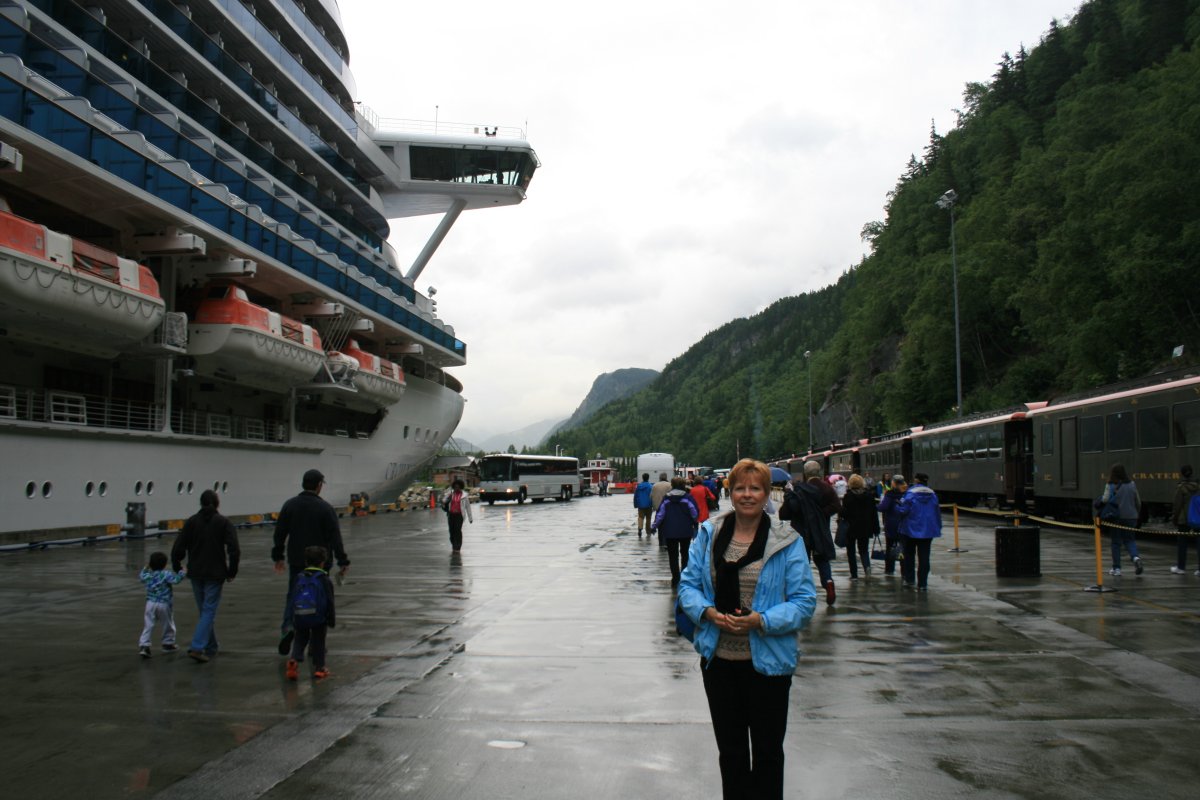 |
|
| Looking back at the Crown Princess. Very scenic. But still not good flying weather. |
| |
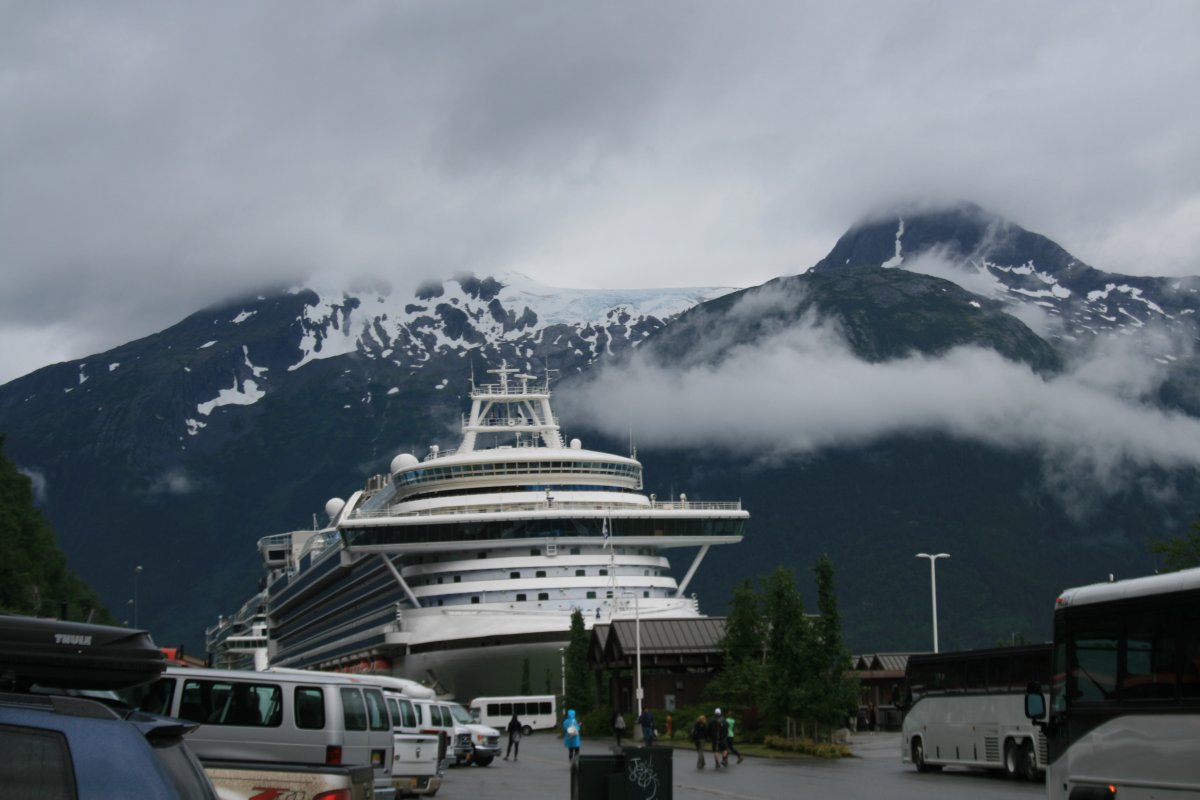 |
|
|
In 1896, before the Klondike gold rush had begun, a group of investors saw an opportunity for a railroad over the White Pass from Skagway. It was not until May 1898 that the White Pass and Yukon Route began laying narrow gauge railroad tracks in Skagway. The railroad depot was constructed between September and December 1898. The railroad ultimately destroyed the viability of Dyea and the Chilkoot Trail, as Skagway had both the deep-water port and the railroad.
The White Pass and Yukon Route is a Canadian and U.S. Class II 3 ft narrow-gauge railroad linking the port of Skagway, Alaska, with Whitehorse, the capital of Yukon. An isolated system, it has no direct connection to any other railroad. Equipment, freight and passengers are ferried by ship through the Port of Skagway, and via road through a few of the stops along its route.
The railroad began construction in 1898 during the Klondike Gold Rush as a means of reaching the goldfields. With its completion in 1900, it became the primary route to the interior of the Yukon, supplanting the Chilkoot Trail and other routes. The gold rush was primarily focused in the region around Dawson City in Yukon and the Yukon River. Of the several overland routes, the Chilkoot Trail was the most direct, least expensive, and, soon enough, most popular.
The other primary route to the headwaters of the Yukon River, however, was also based out of Skagway: the rival White Pass route. The White Pass route was slightly longer but less rigorous and steep, whereas the Chilkoot was shorter and more difficult. Skagway, because of its deepwater harbor, served as the principal port for both routes (nearby Dyea, the beginning of the Chilkoot Trail, was built on the extensive, shallow Taiya River delta).
Prospectors who chose the Chilkoot were ferried to Dyea by small boat or ferry. Soon, both Skagway and Dyea were bustling tent cities as sensationalist headlines of the gold rush spurred men from across the United States to leave their jobs and families and gain passage up the Inside Passage to Skagway.
As it became apparent that many of the prospectors who chose the Chilkoot simply were not going to survive the arduous terrain and harsh weather, Canada's North-West Mounted Police (now the Royal Canadian Mounted Police) declared that prospectors could only enter Canada if they had at least one ton of gear (enough to supply a prospector for one year. See also: Klondike supply list).
Prospectors ferried the gear from campsites along the trail, slowly moving closer to the headwaters of the Yukon. With all the equipment and supplies being transported, alternative methods, especially those with a little supplemental income, sprouted up. Many prospectors purchased pack animals (although that method was more commonly used on the rival White Pass), and many others paid Tlingit Indians to haul gear on a per-pound rate from campsite to campsite.
The railway closed down on October 7, 1982 when the commercial market dried up. But tourism saved it. The White Pass was and is perfectly positioned to sell a railroad ride through the mountains to cruise ship tourists; they do not even have to walk far. The White Pass Route was reopened between Skagway and White Pass in 1988 purely for tourist passenger traffic. The railway still uses vintage parlor cars, the oldest four built in 1881 and predating WP&YR by 17 years, and new cars follow the same 19th century design. In July 2018, the railway was purchased by Carnival Corporation; you know, Carnival Cruises.
Our group on the train. The lady at lower right is thinking "I made a bad decision when I choose this car."
|
| |
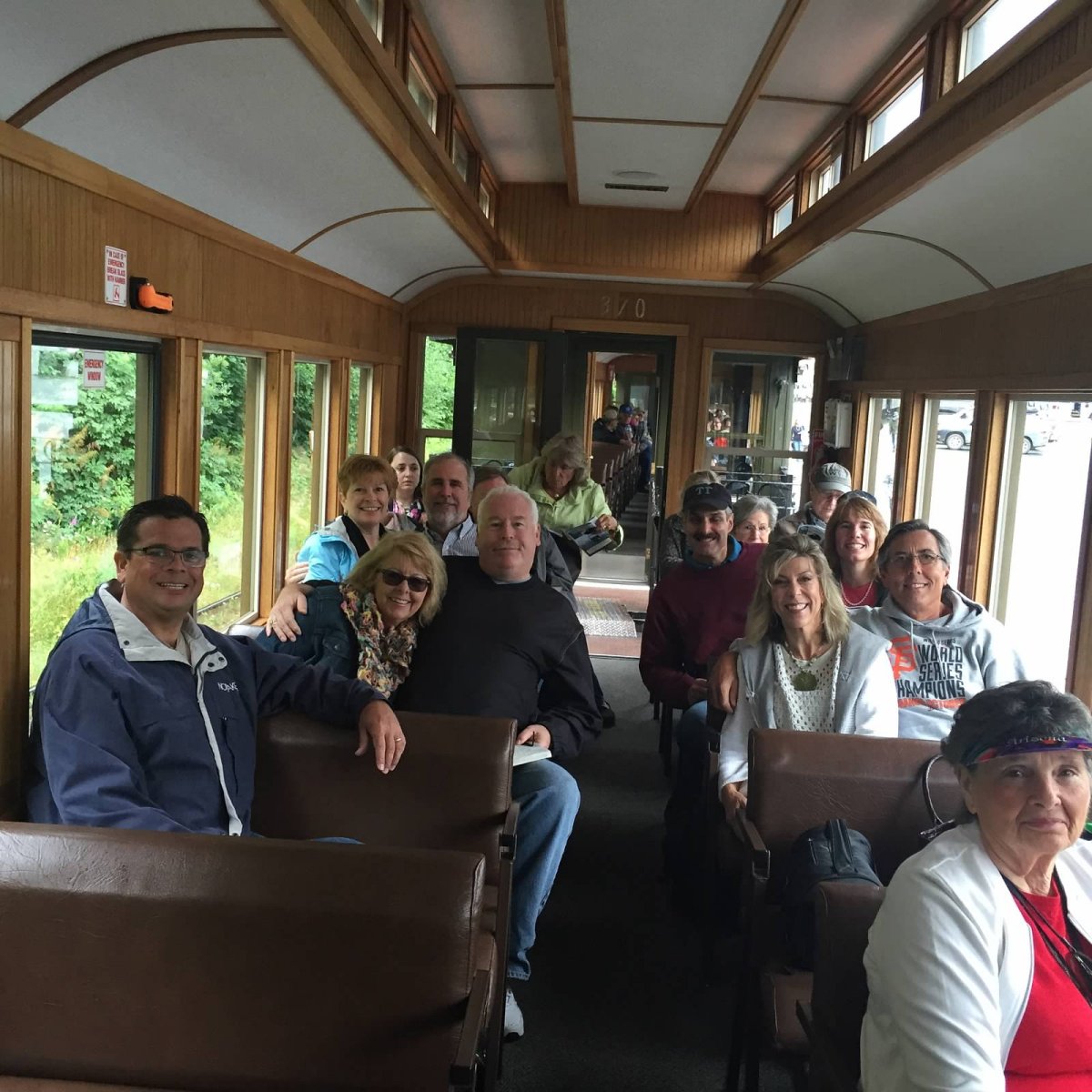 |
|
| Map of the White Pass and Yukon Route. Can you imagine having to transport one ton of supplies by pack animal or backpack? |
| |
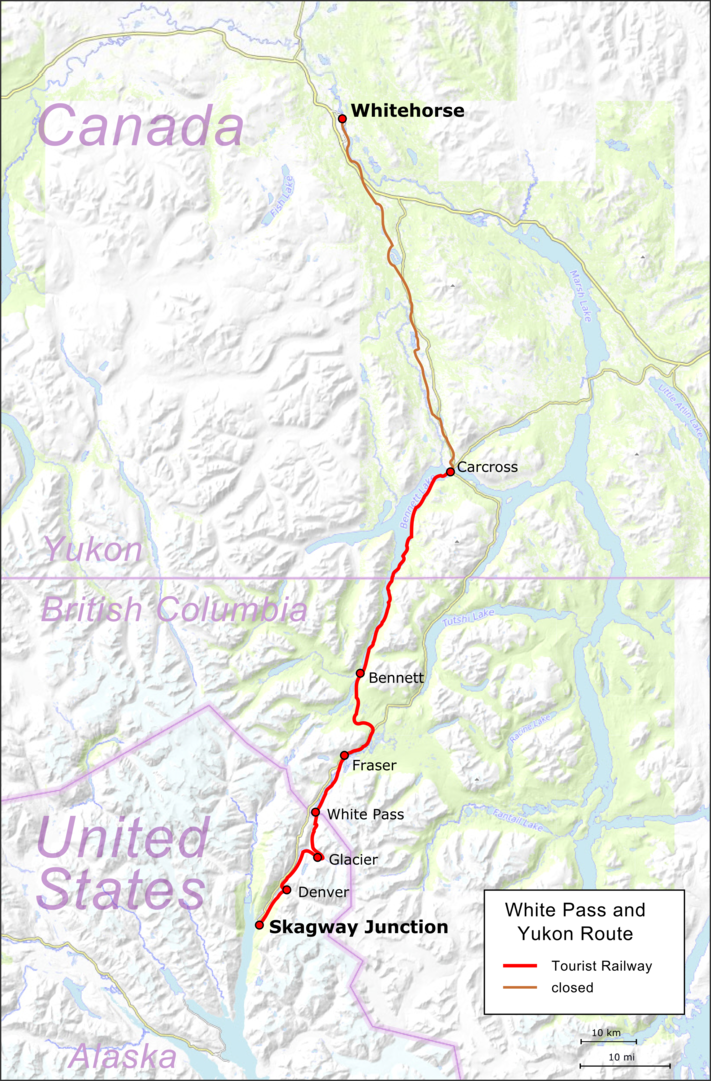 |
|
| Map of the Chilkoot Trail with the White Pass Yukon Route Railroad path visible. Our train only went to the White Pass, at the U.S./Canada border, to the lower right of #5. |
| |
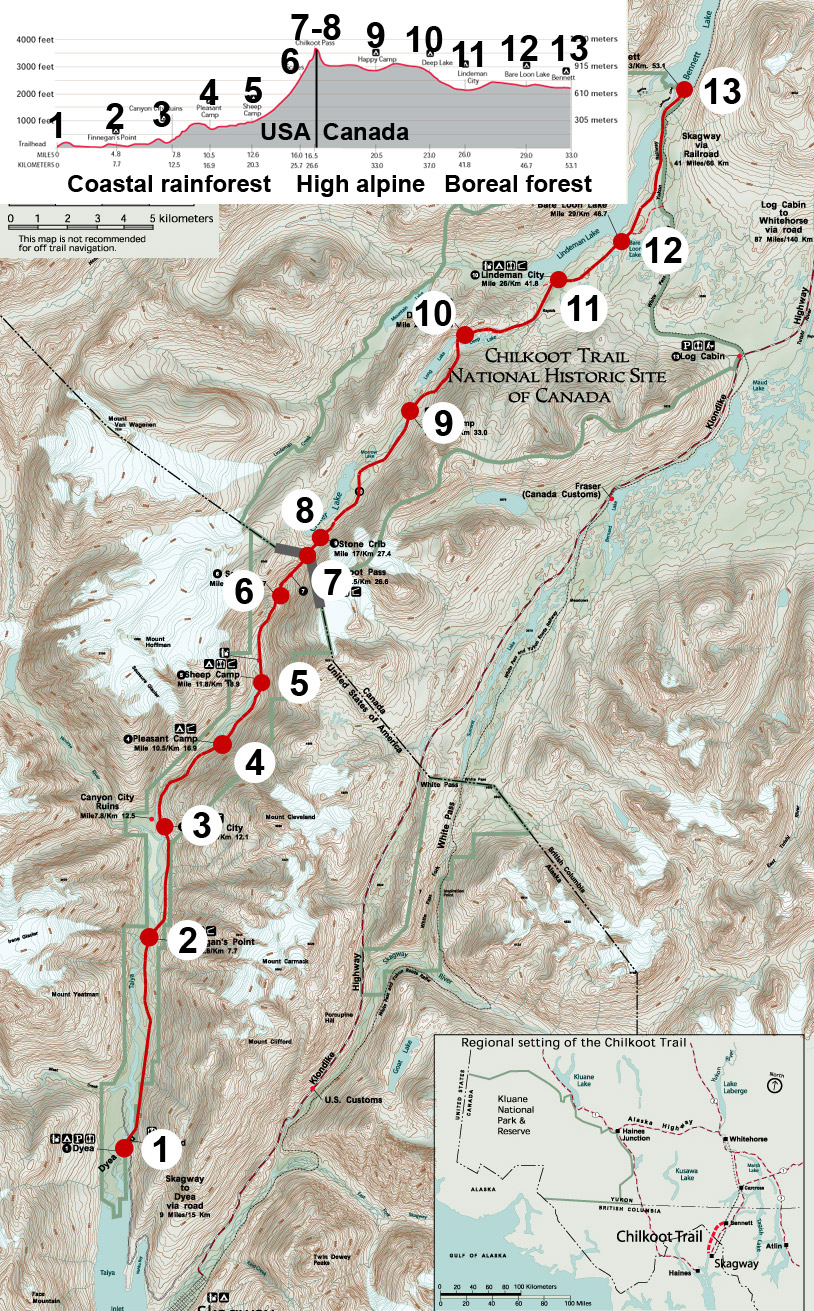 |
|
| |
| |
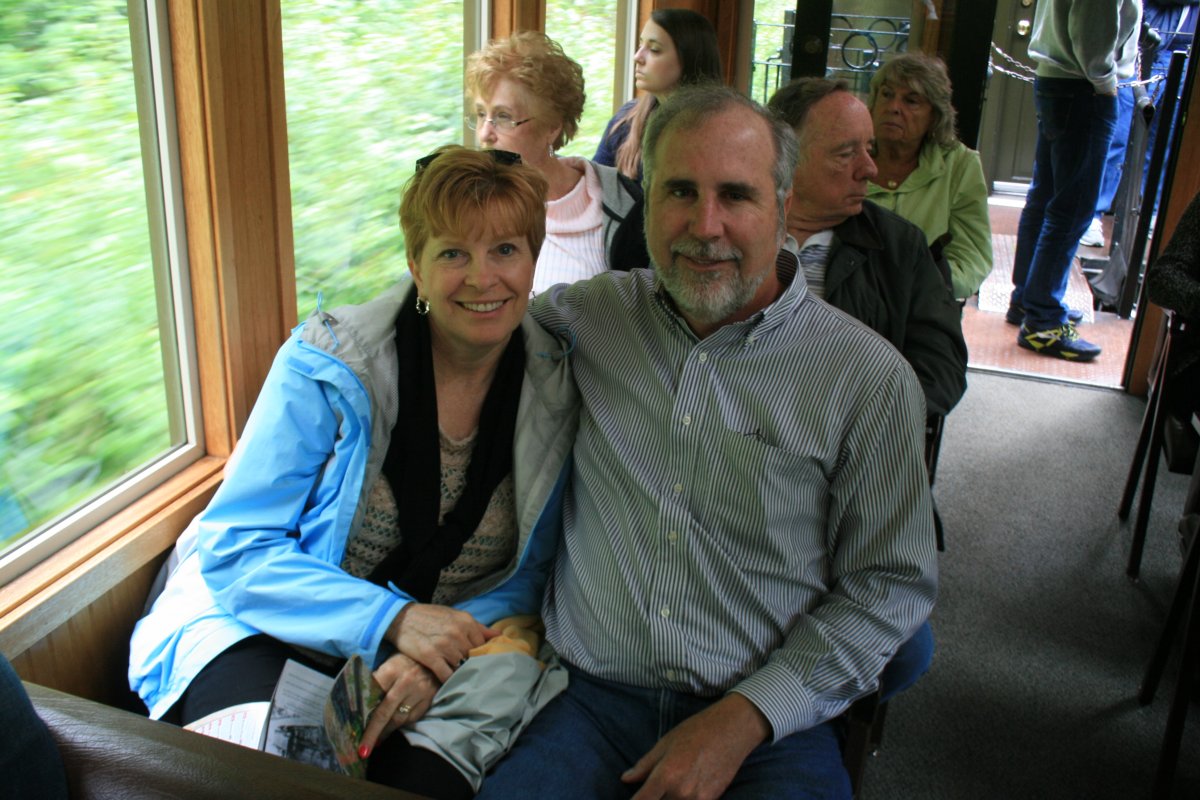 |
|
| Dave and Jenny |
| |
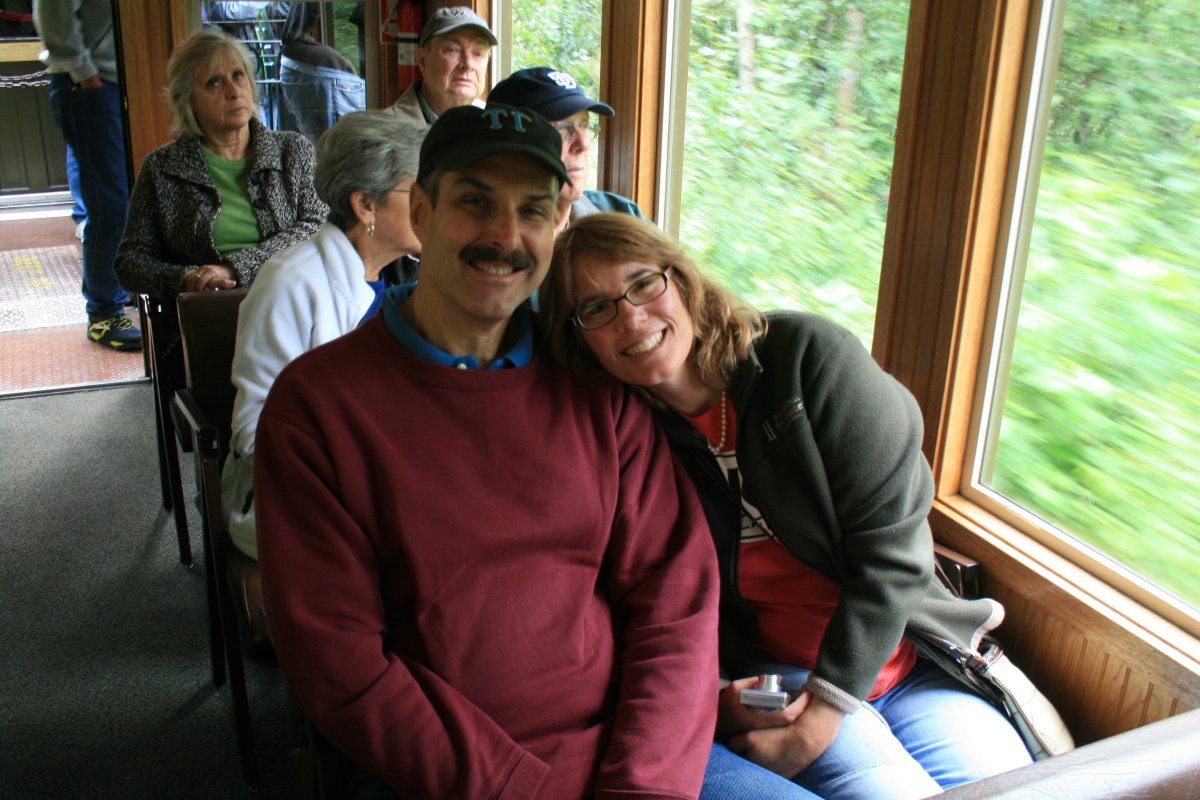 |
|
| |
| |
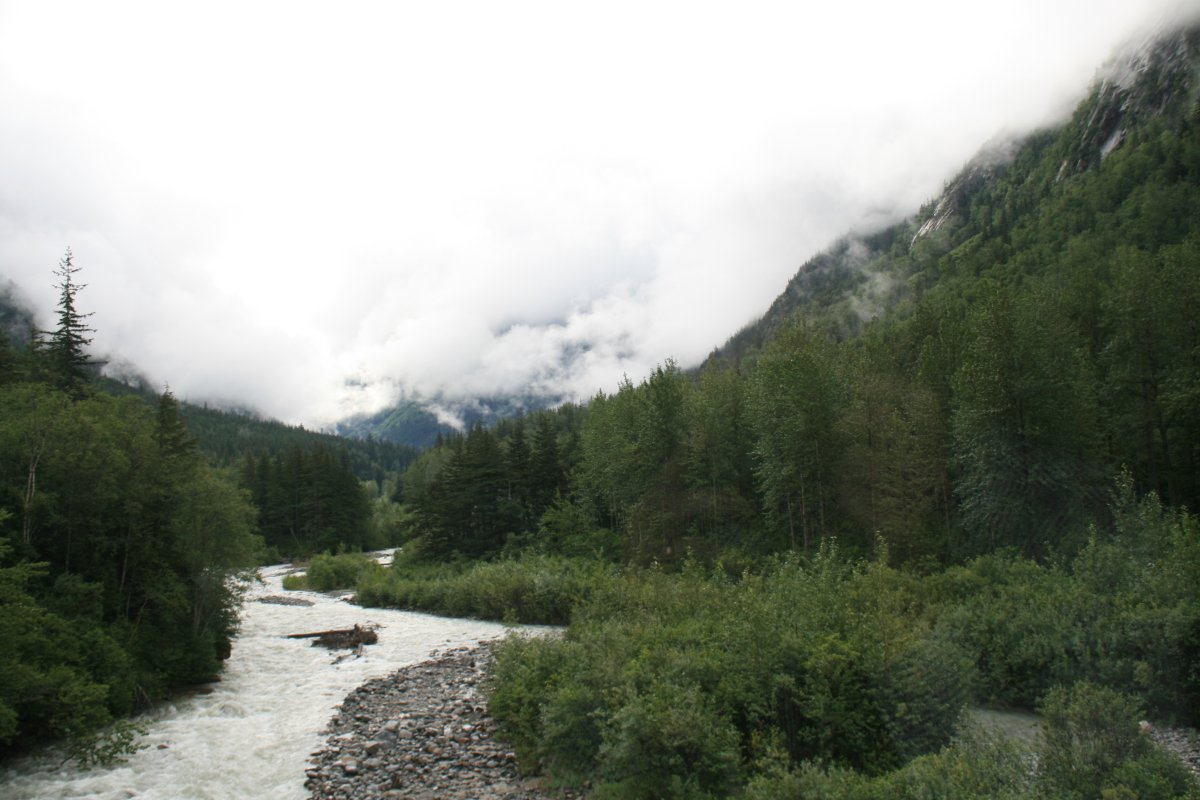 |
|
|
Looking back south towards Skagway. The Crown Princess is just visible.
|
| |
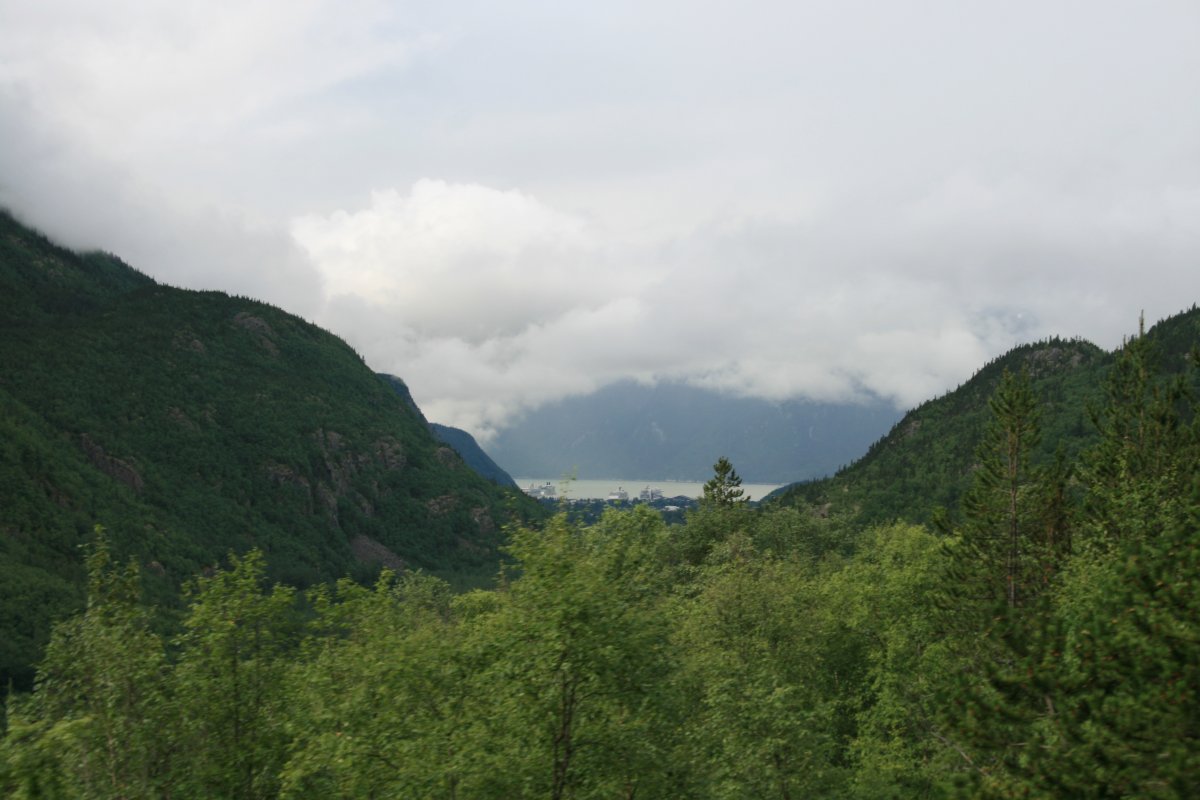 |
|
|
The big windows in the vintage parlor cars are great for sightseeing. Four of the cars were actually built in 1881 -- predating WP&YR by 17 years. Newer cars follow the same 19th century design.
|
| |
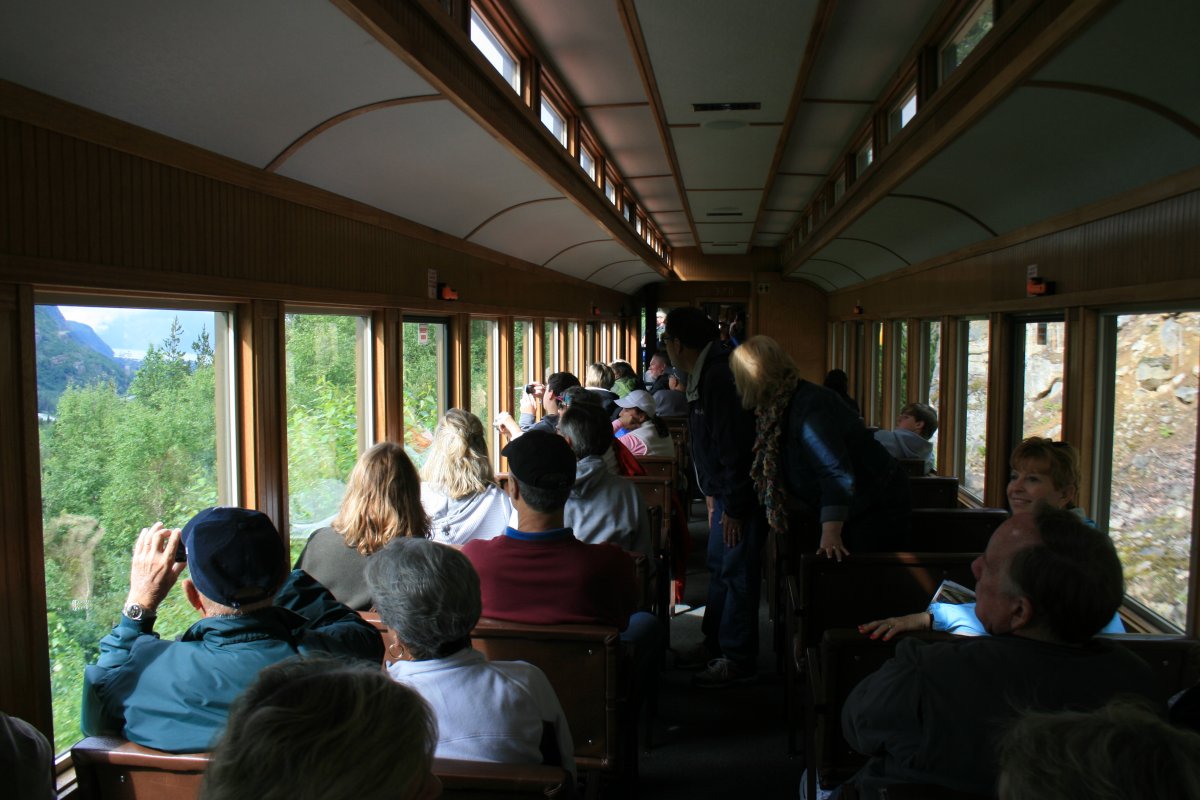 |
|
|
The train will make a big U-turn to get across the East Fork Skagway River. We will soon be on the other side of this valley; the railroad track is just visible at the bottom of that low-hanging cloud.
|
| |
 |
|
| We were passing through wilderness. |
| |
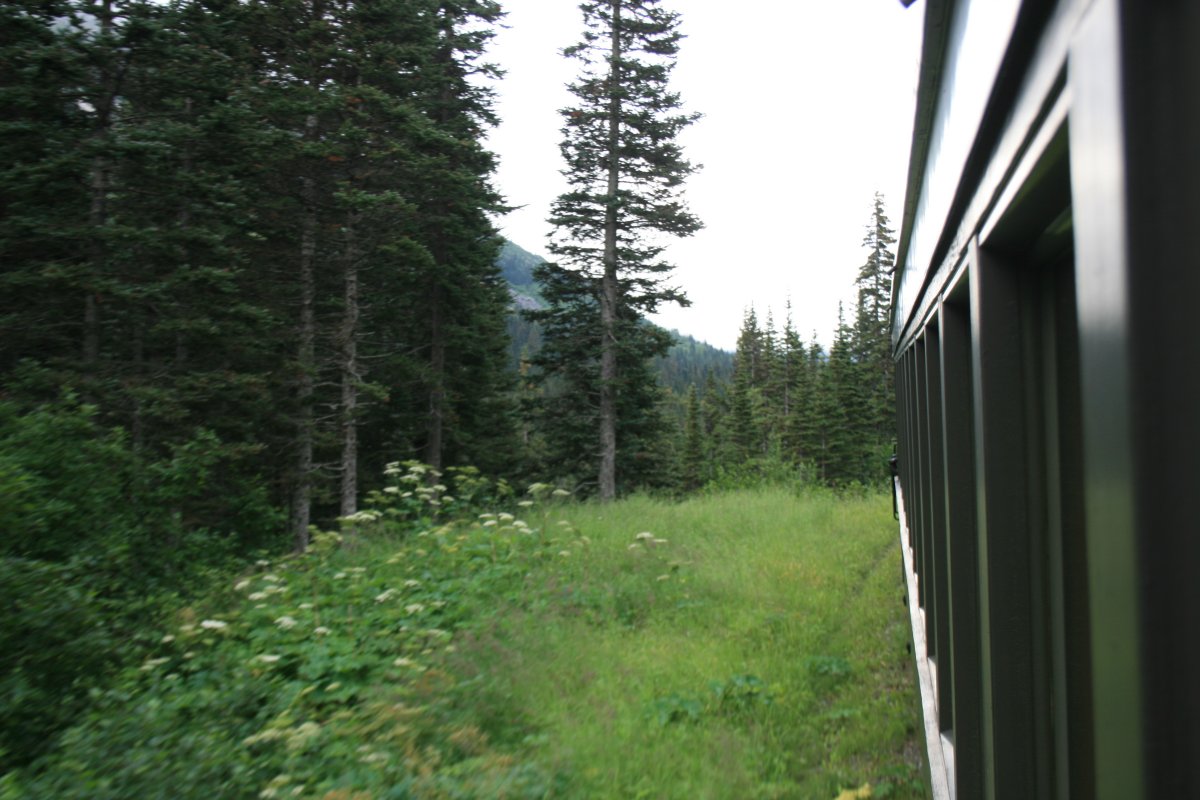 |
|
| |
| |
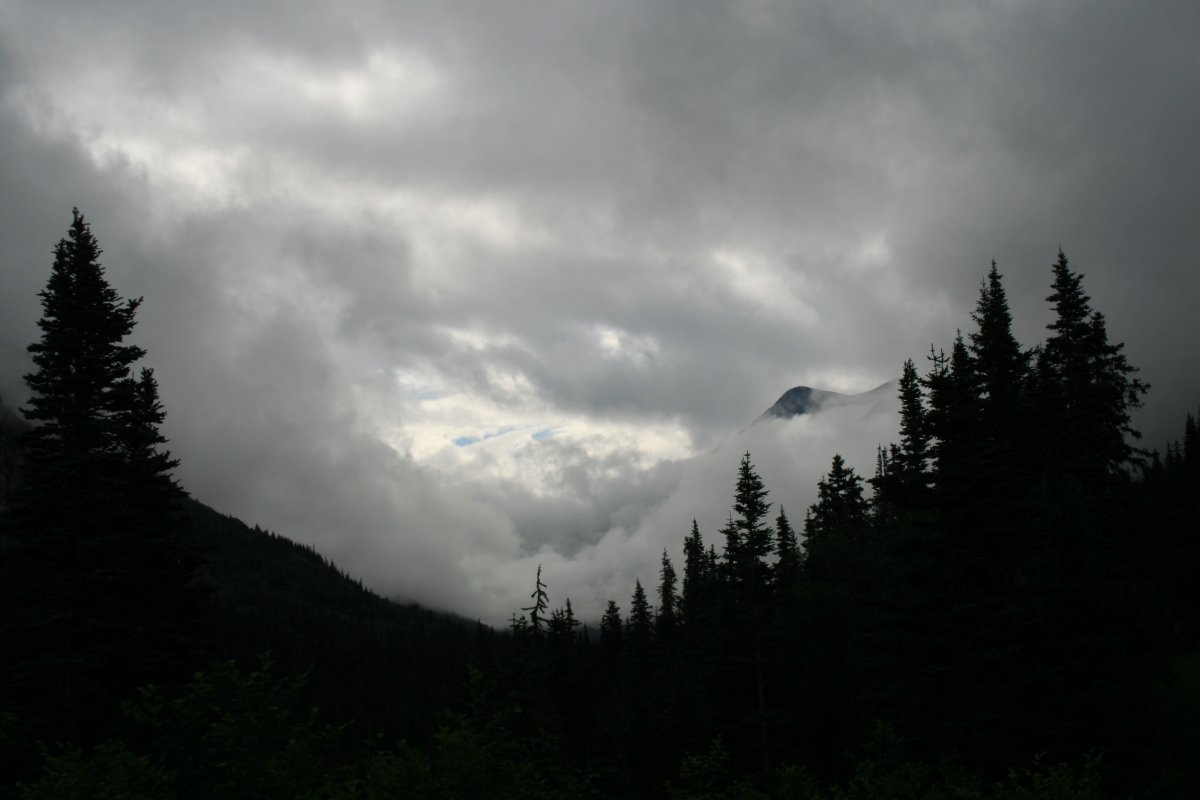 |
|
| Pretty flowers. |
| |
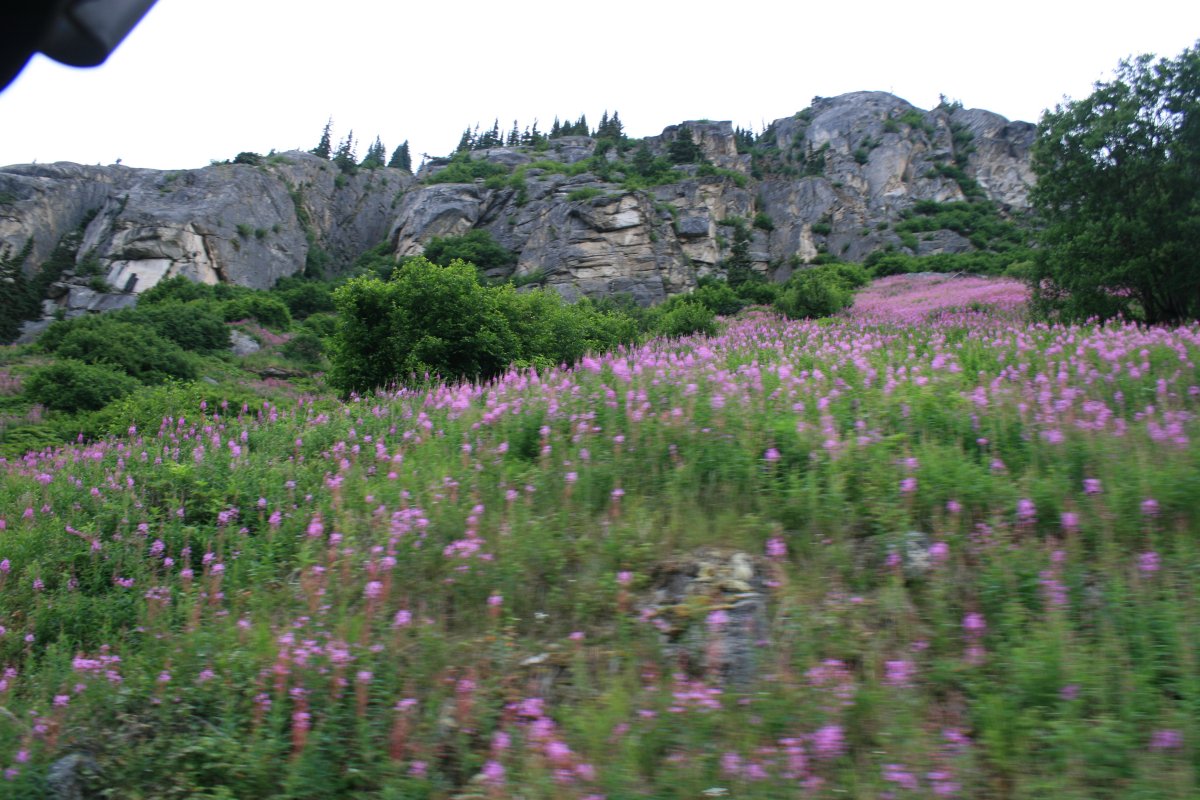 |
|
|
|
| |
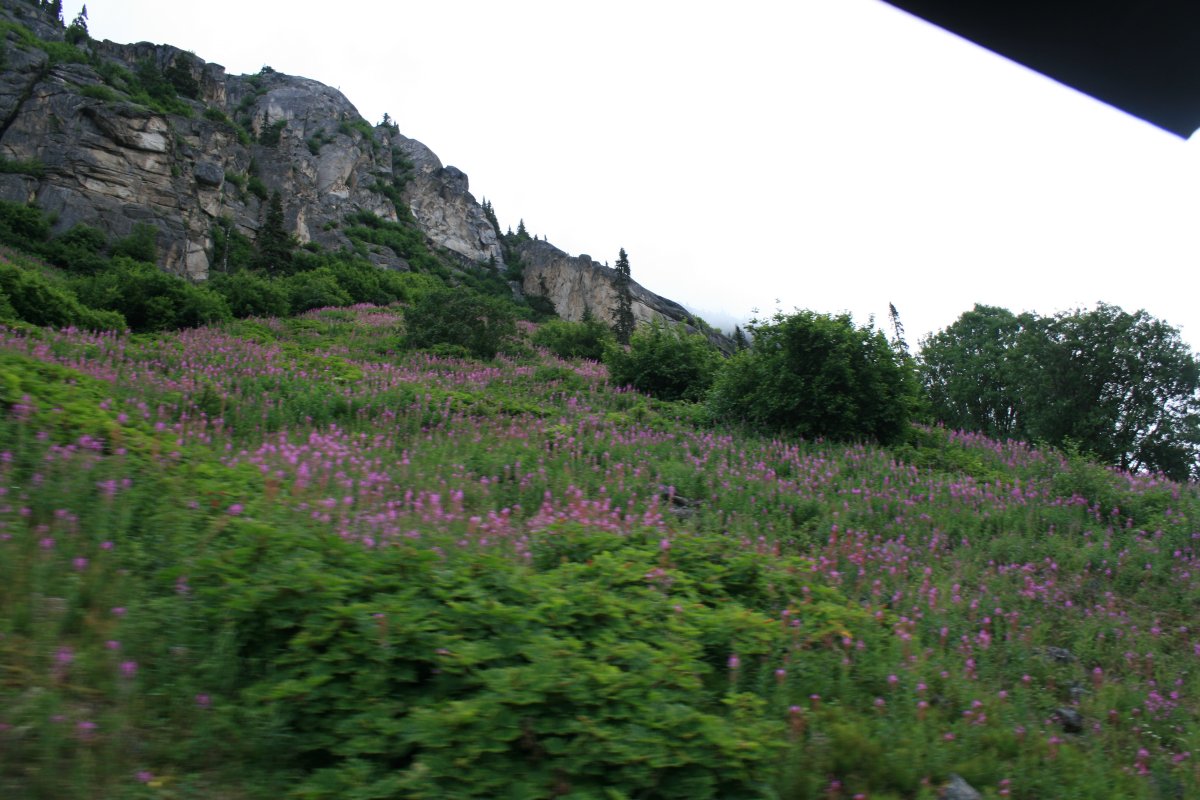 |
|
| Most trains are hauled by the line's diesel locomotives, painted in green (lower) and yellow (upper), but one of the line's steam locomotives is still in operation too, No. 73, a 2-8-2 Mikado-type locomotive. |
| |
 |
|
|
|
| |
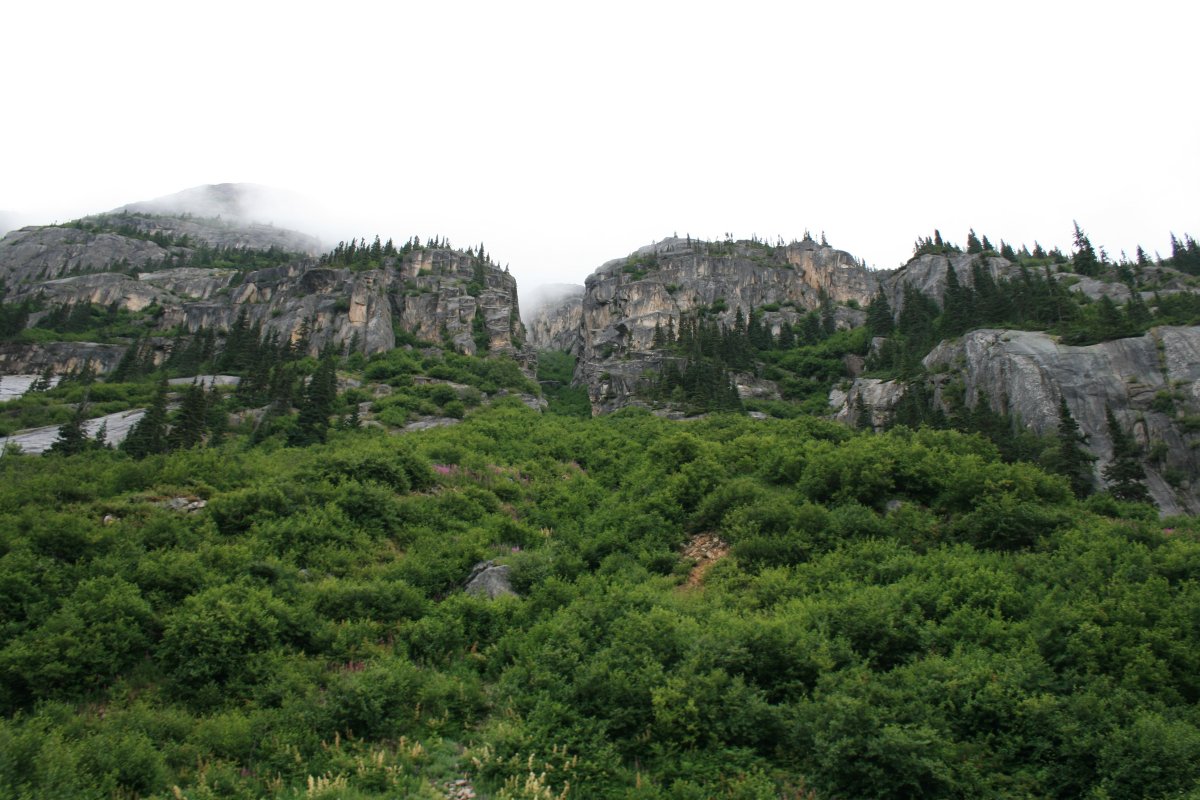 |
|
| Looking across the valley at the way we had come. Another train is visible in the middle of the picture. |
| |
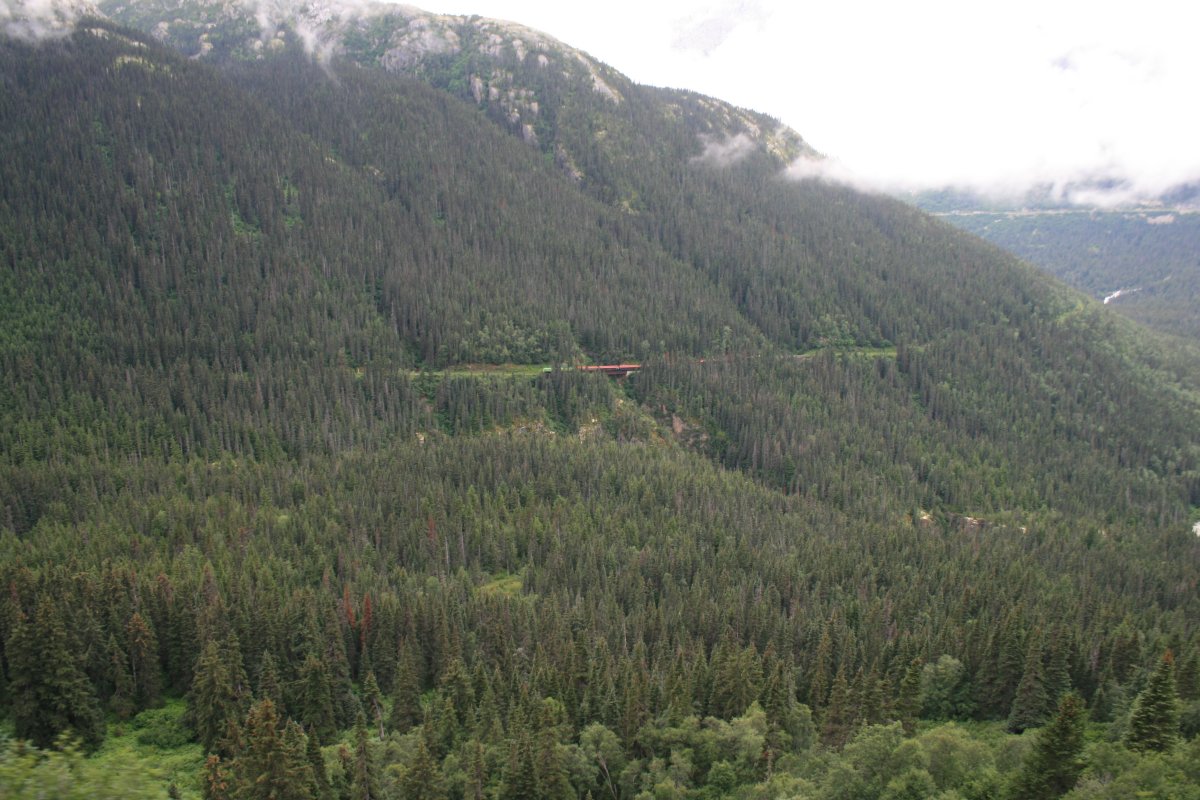 |
|
| A good look at our two Diesel locomotives about to enter a tunnel. |
| |
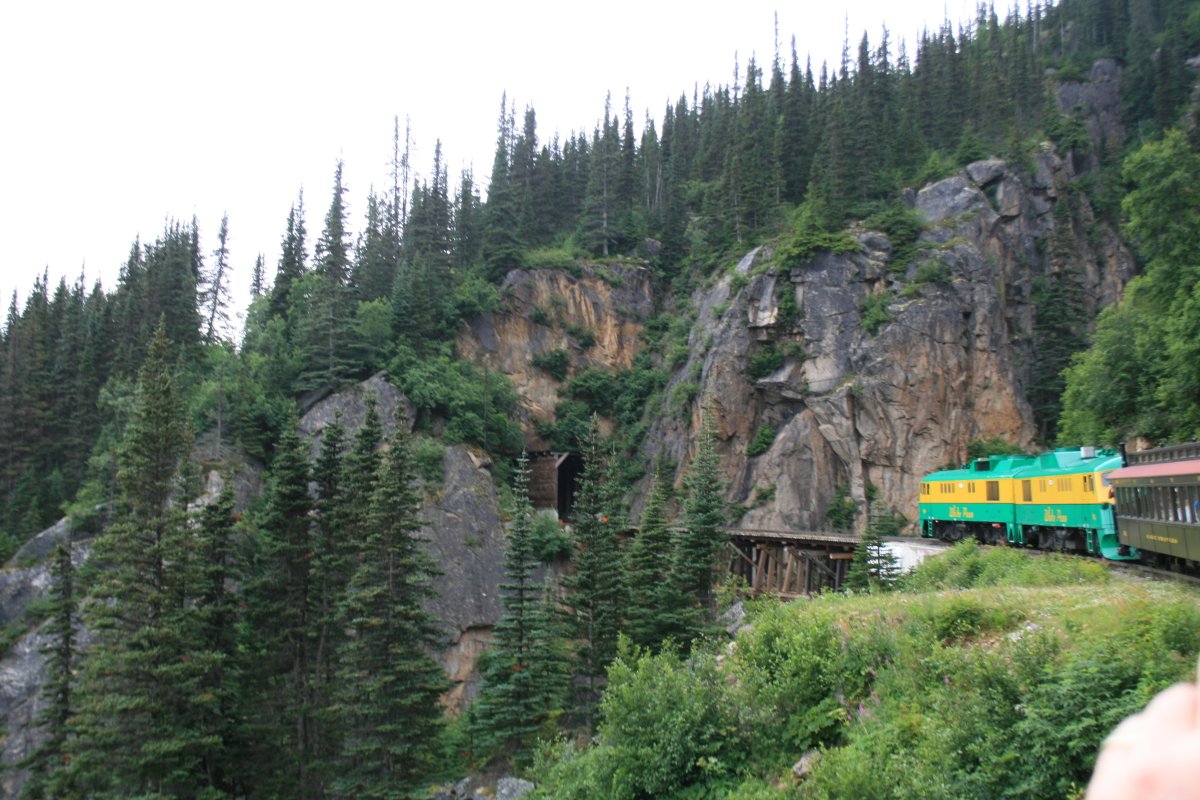 |
|
| Taken from a bridge looking down a ravine. That is the East Fork of the Skagway River. |
| |
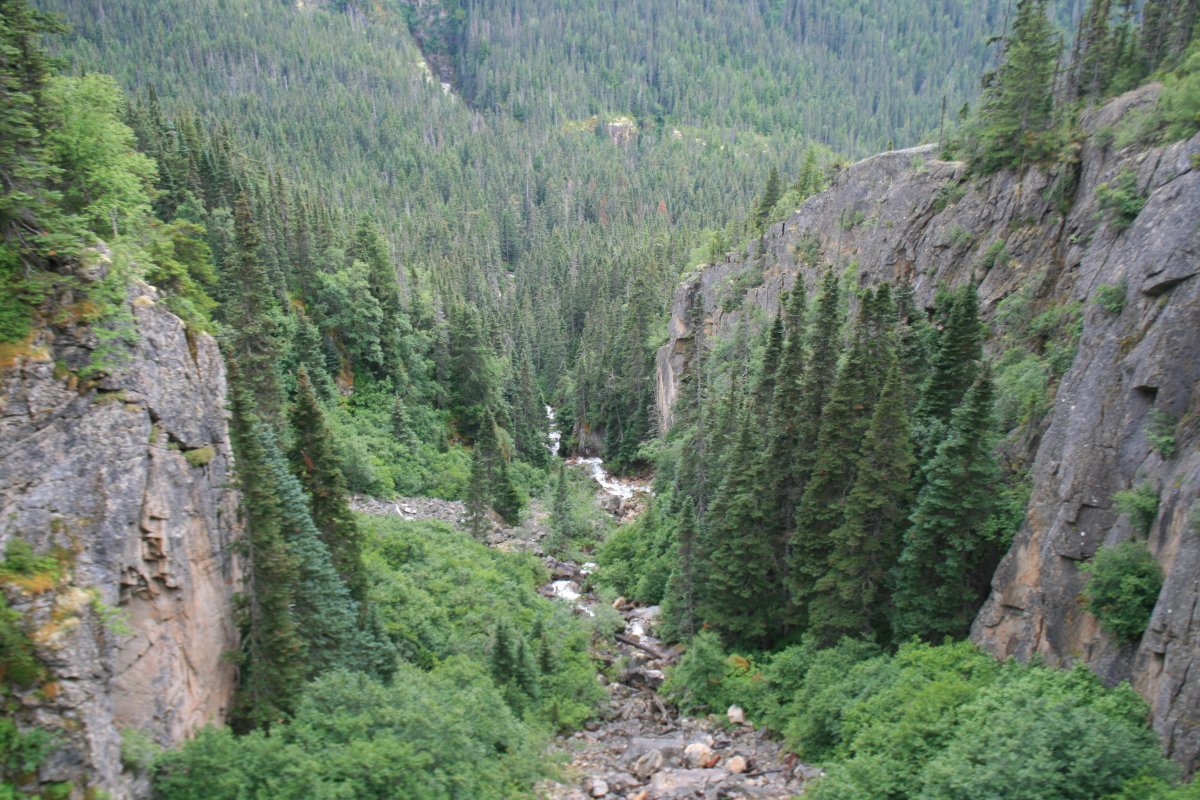 |
|
|
Looking at an old bridge no longer in use.
|
| |
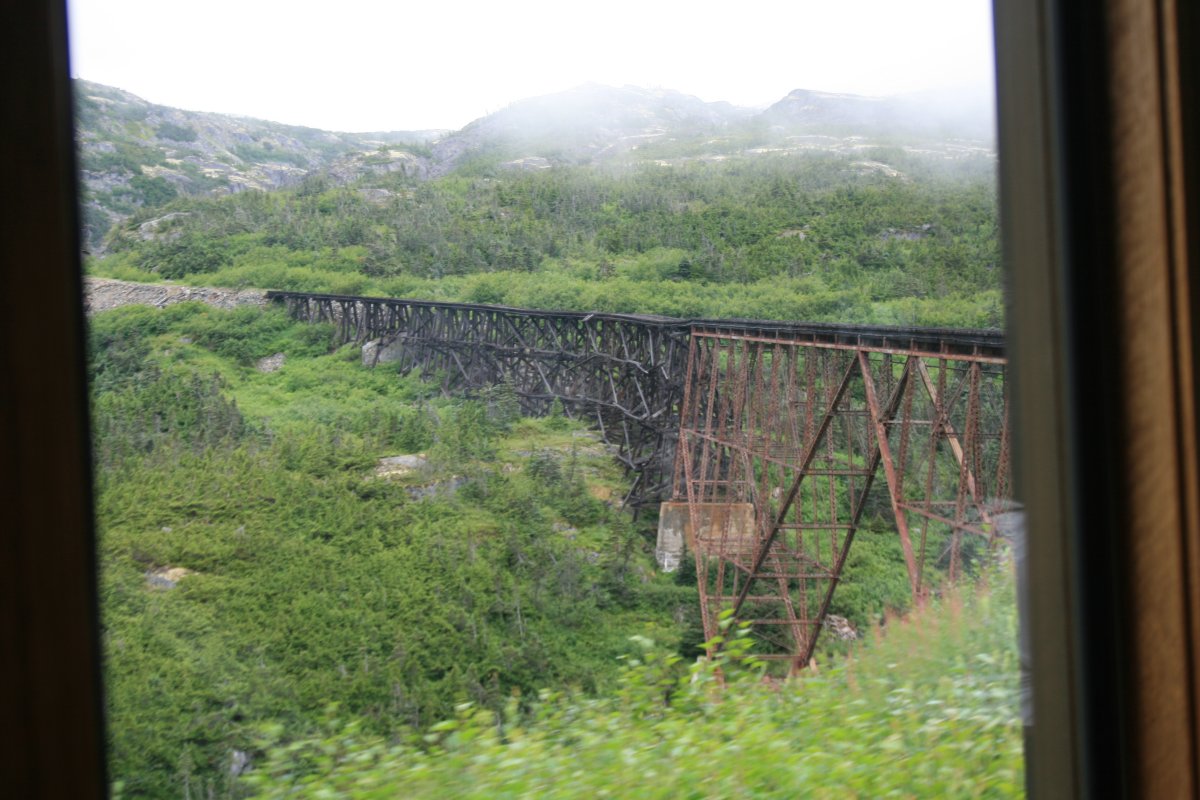 |
|
| Yikes! |
| |
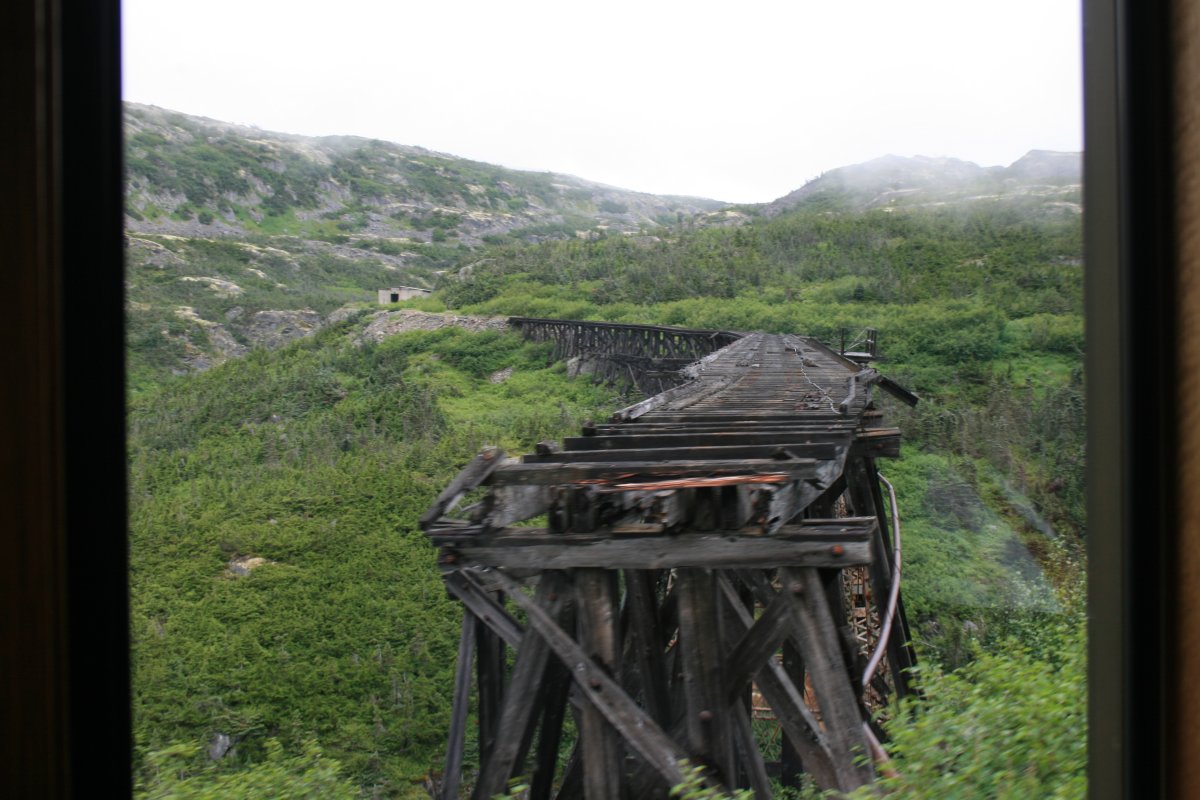 |
|
|
Looking back at the old bridge, known as Steel Bridge. I don't know if I would have wanted to go arcross that thing back in the day. Constructed in 1901, this was the tallest cantilever bridge in the world. It was used until 1969.
|
| |
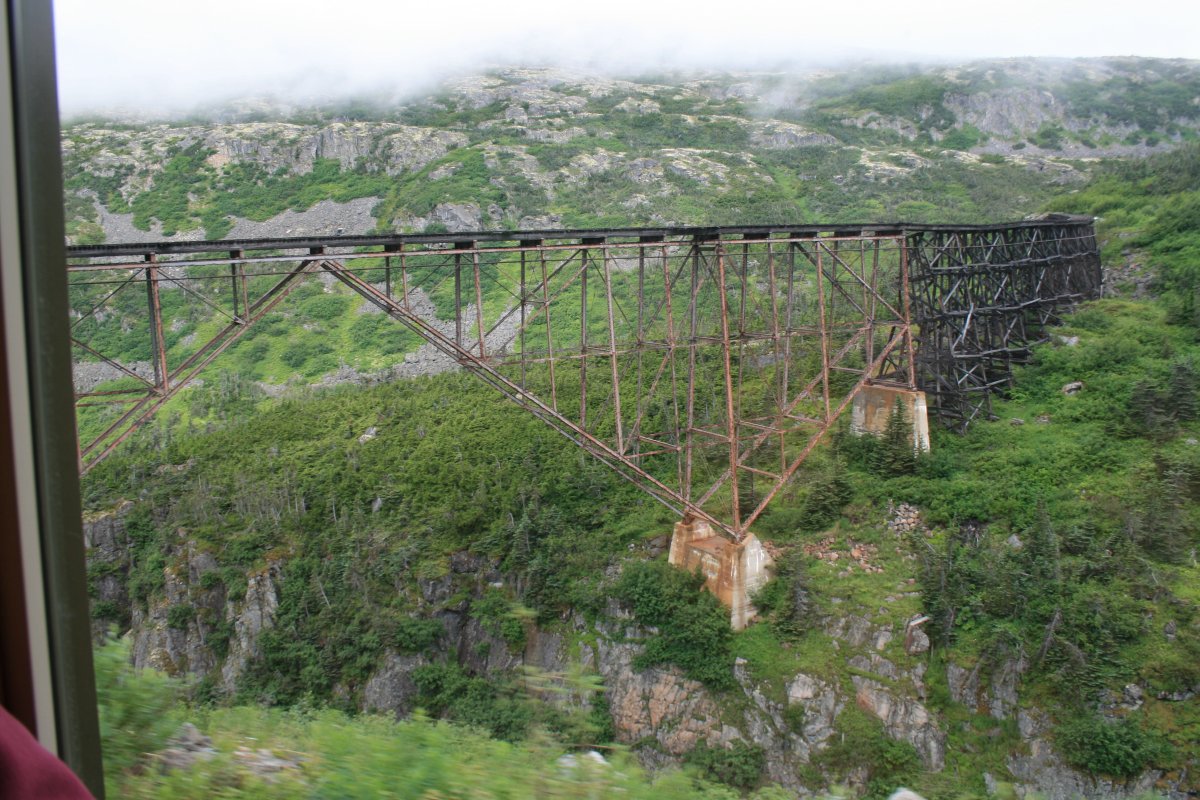 |
|
| |
| |
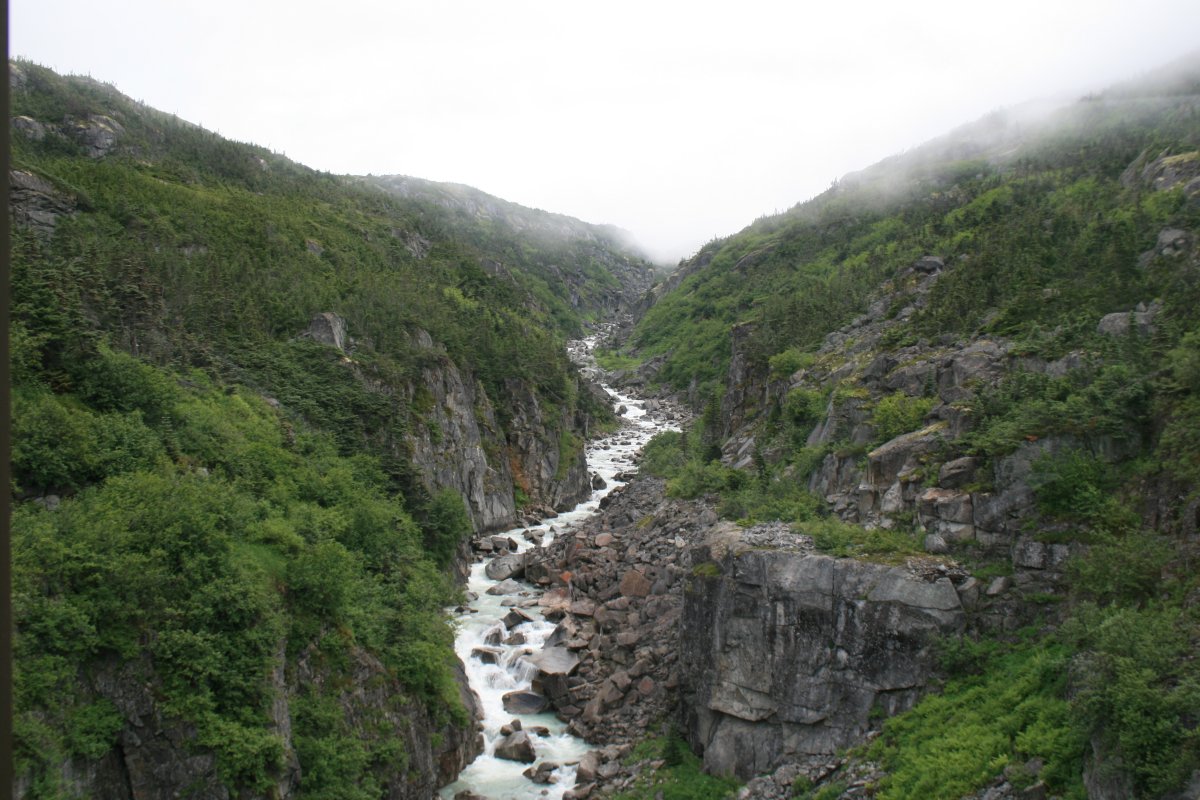 |
|
I believe this was the old White Pass trail used by the prospectors and pack animals. It was also called Dead Horse trail which gives you an indication of its severity.
The White Pass trail was one of the two main passes used by prospectors during the Klondike Gold Rush. The White Pass was an easier route to Lake Bennett than the Chilkoot Trail a few kilometers to the west, but it harbored a criminal element that preyed on the cheechakos (newcomers to the Klondike). So many horses died during the gold rush, the trail became known as the "Dead Horse Trail". The trail ended at Lake Bennett, where the prospectors built or purchased rafts or boats to float down the Yukon River to the Klondike gold fields near Dawson City.
The White Pass and Yukon Route (W.P. & Y.R.) narrow-gauge railroad was built 1898-1900[4] through White Pass.
|
| |
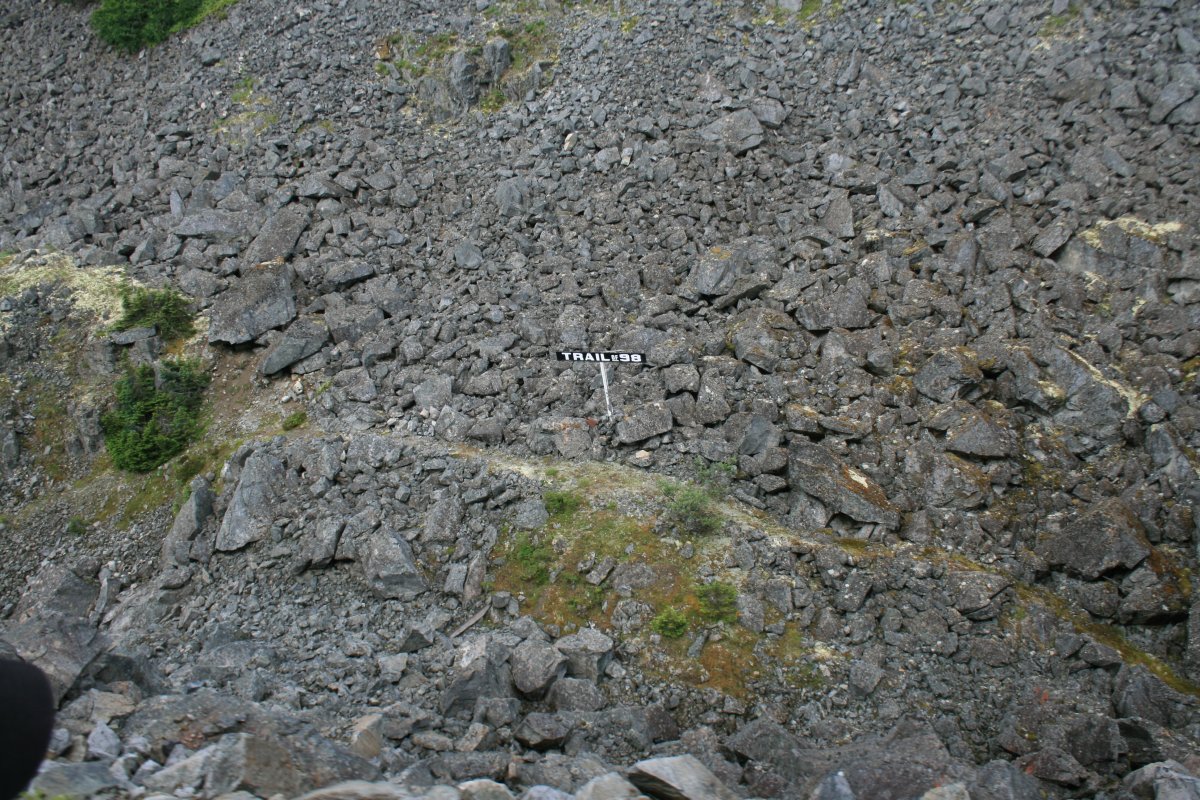 |
|
| The White Pass trail in winter in 1899. You had to be tough back then. |
| |
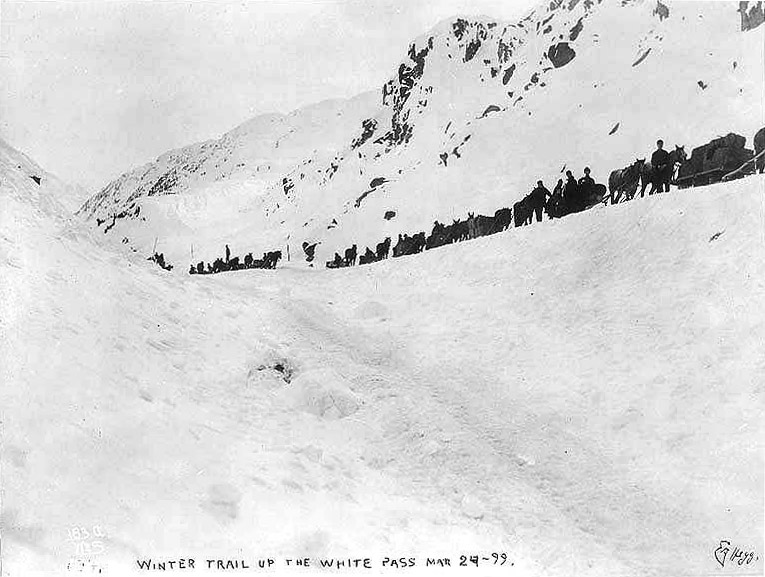 |
|
| We are in high alpine country. |
| |
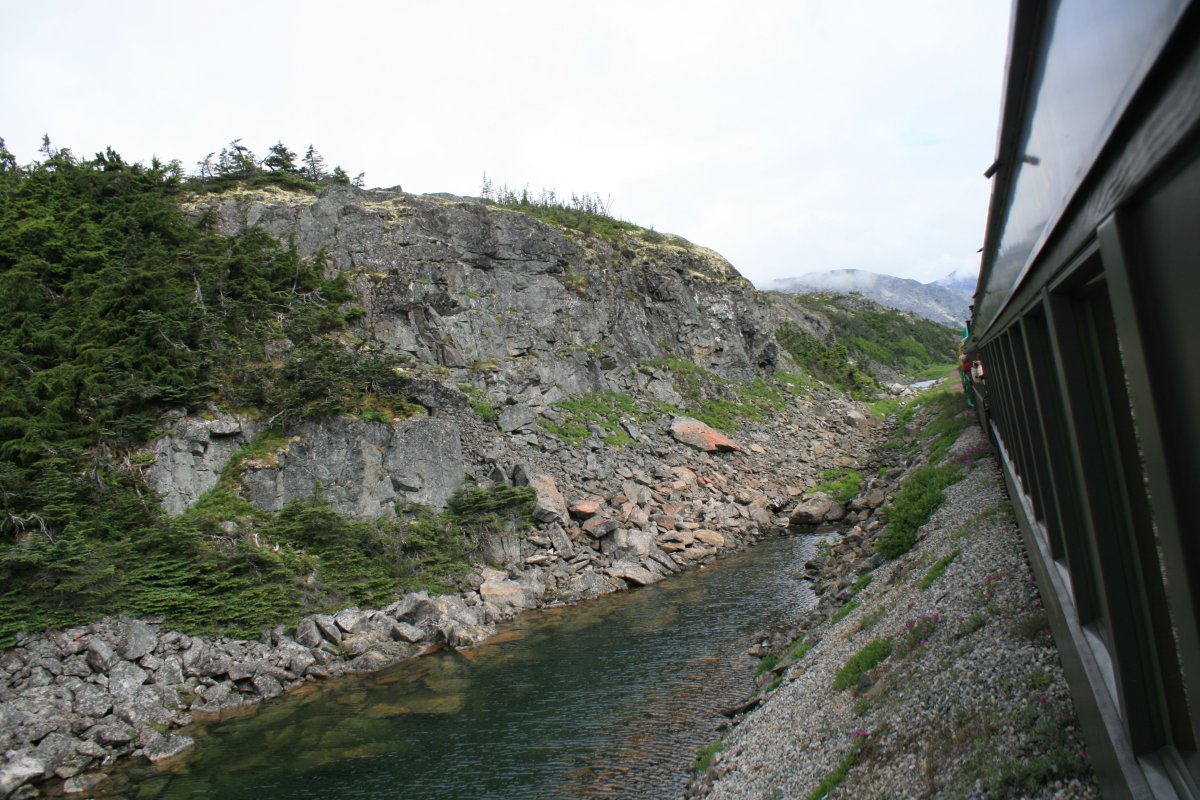 |
|
| We have reached the White Pass Summit which is on the U.S./Canadian border. NWMP stands for Canadian North-West Mounted Police. You know them know as the Royal Canadian Mounted Police. |
| |
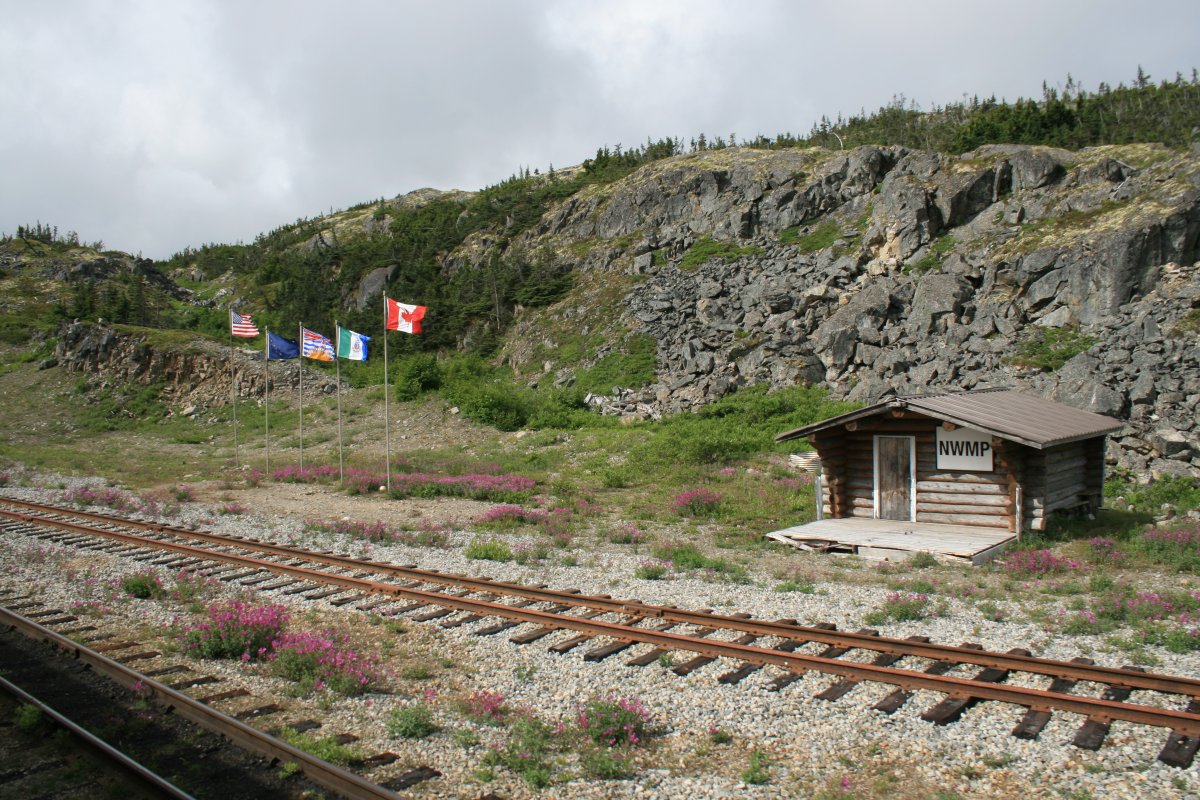 |
|
| Just a short ways further was Summit Lake which is where the train stopped for awhile before heading back to Skagway. I wish we could have gone all the way to Bennett or Carcross. Some other day. It's beautiful country. |
| |
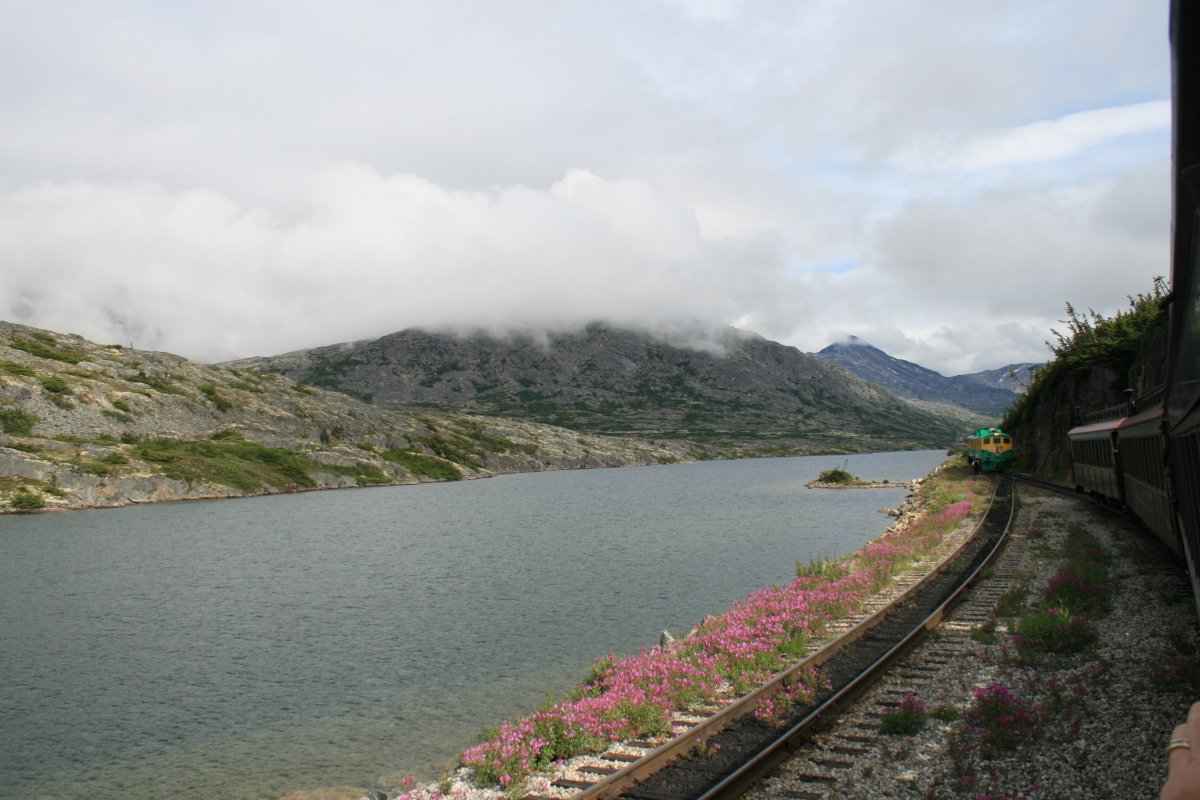 |
|
| Nice picture at Summit Lake. |
| |
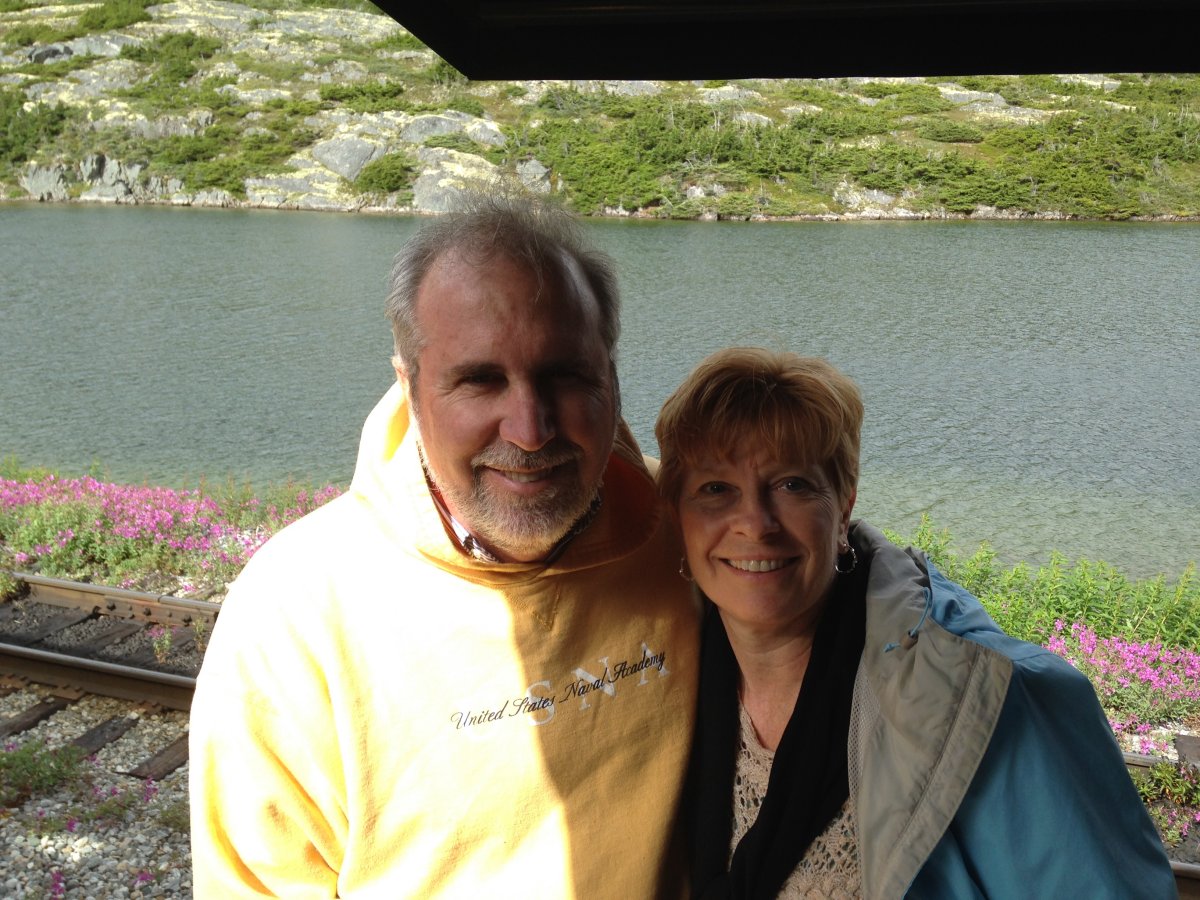 |
|
|
Dave has always liked trains. He has a model railroad empire in his basement. He got pretty excited when he saw the train conductor.
|
| |
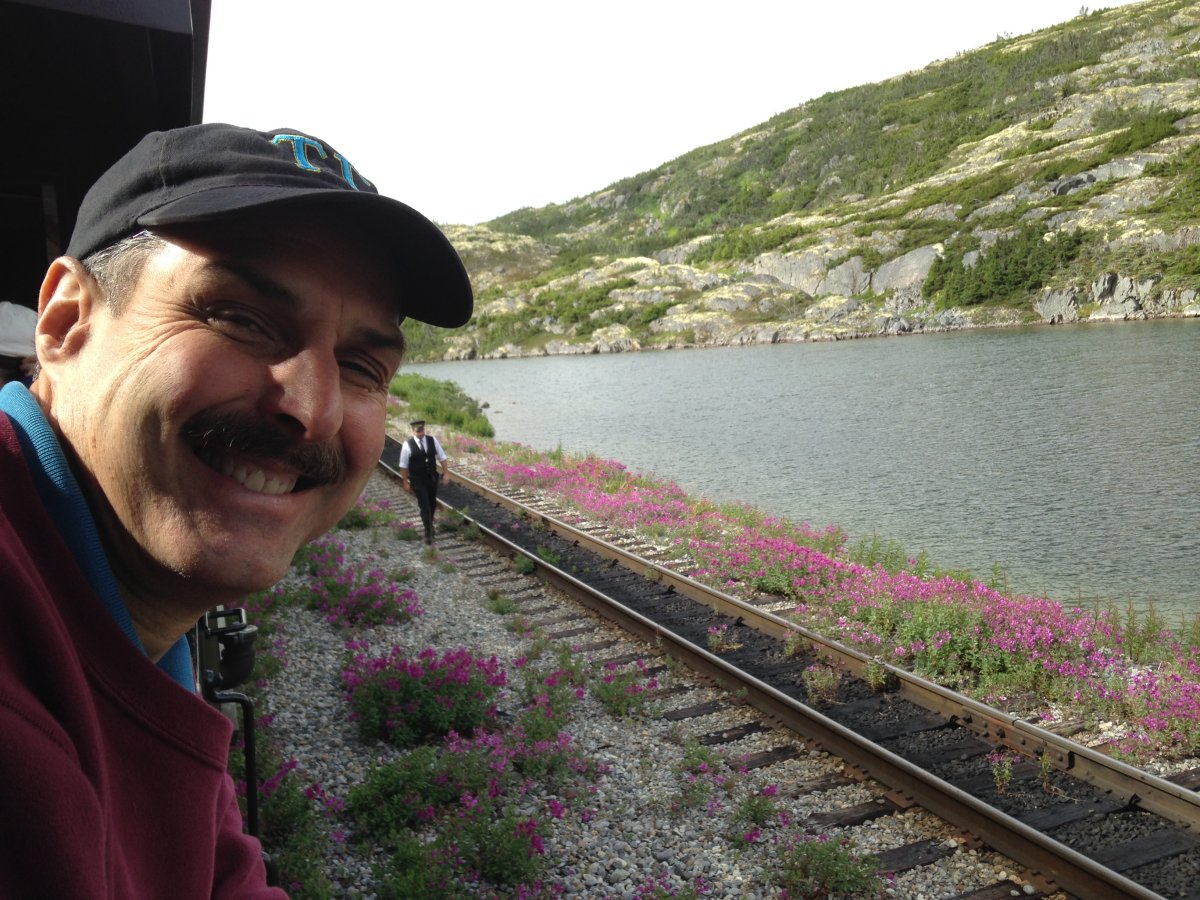 |
|
| The girls ... and Jack. |
| |
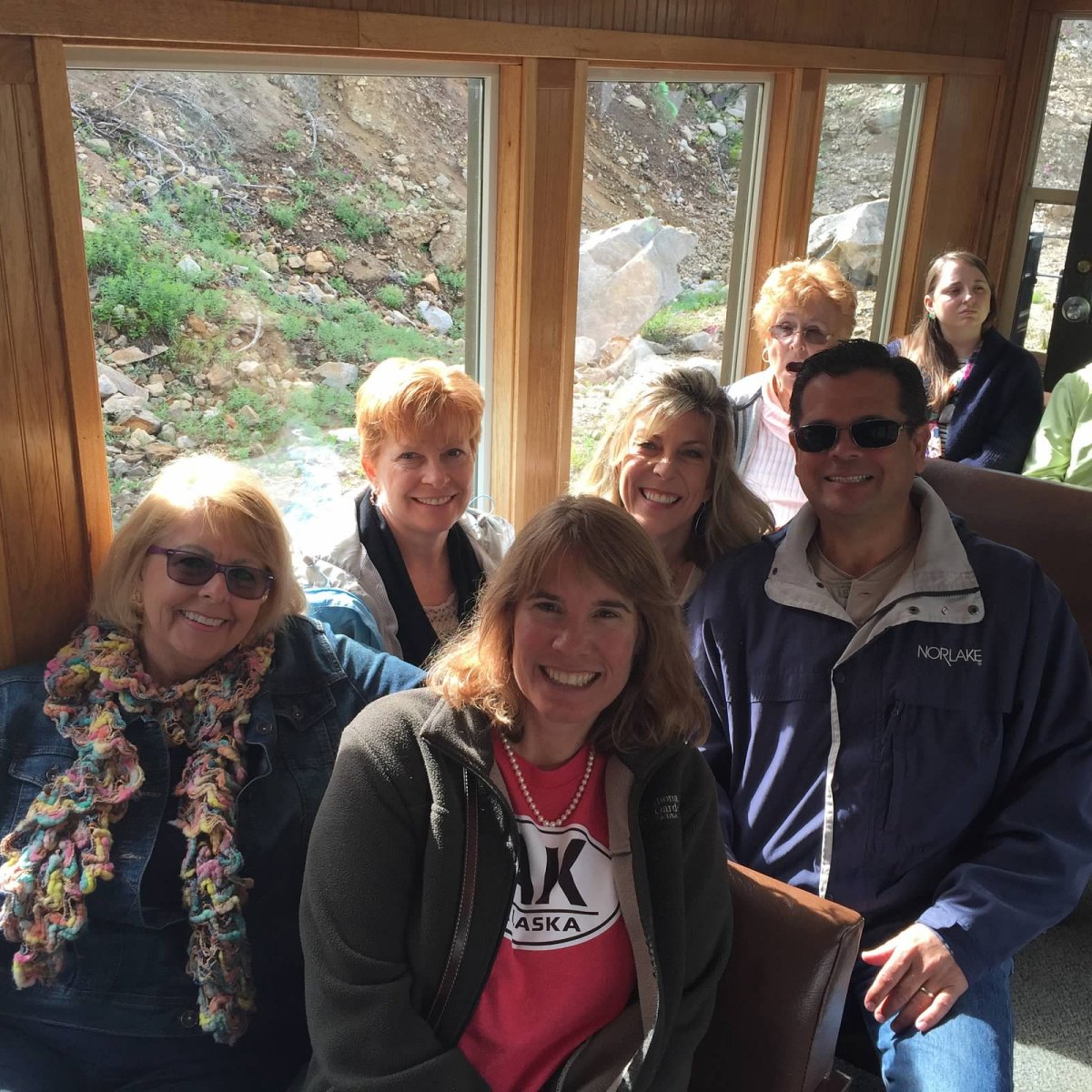 |
|
|
We headed back down the hill. Looking south towards Skagway.
|
| |
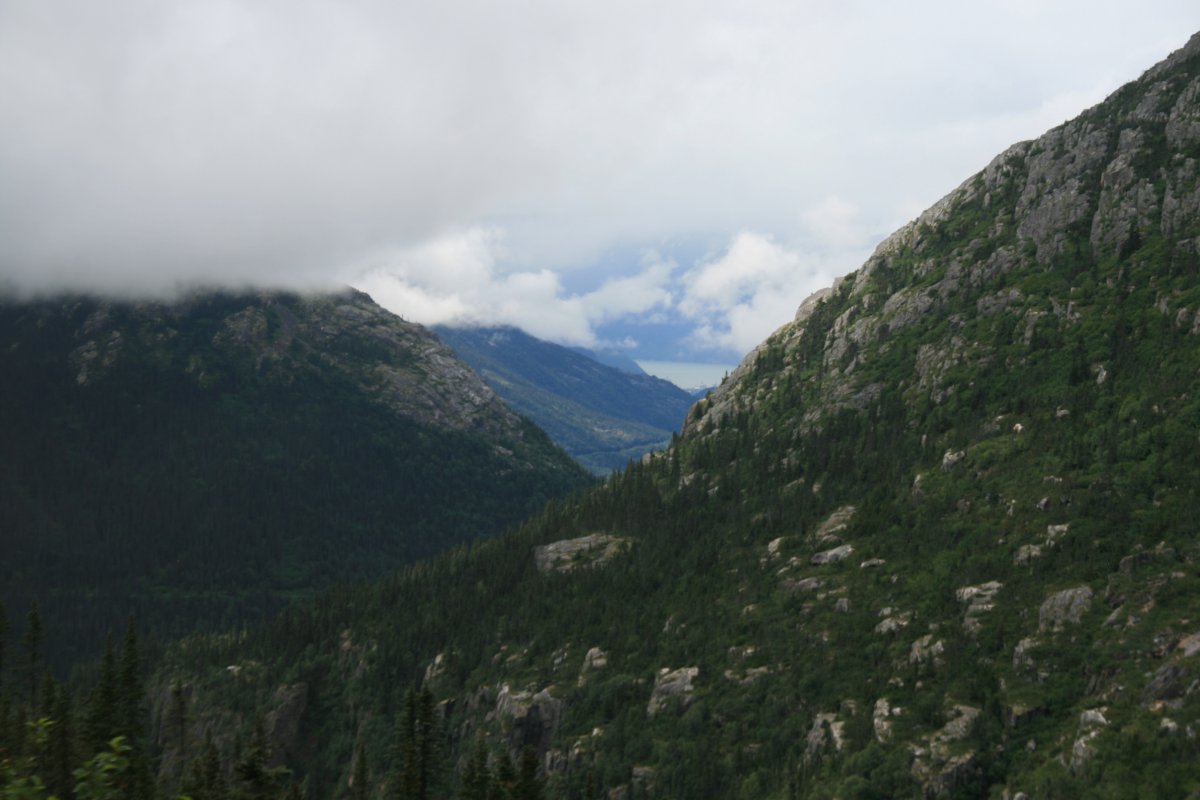 |
|
| A good look at the vintage parlor cars. |
| |
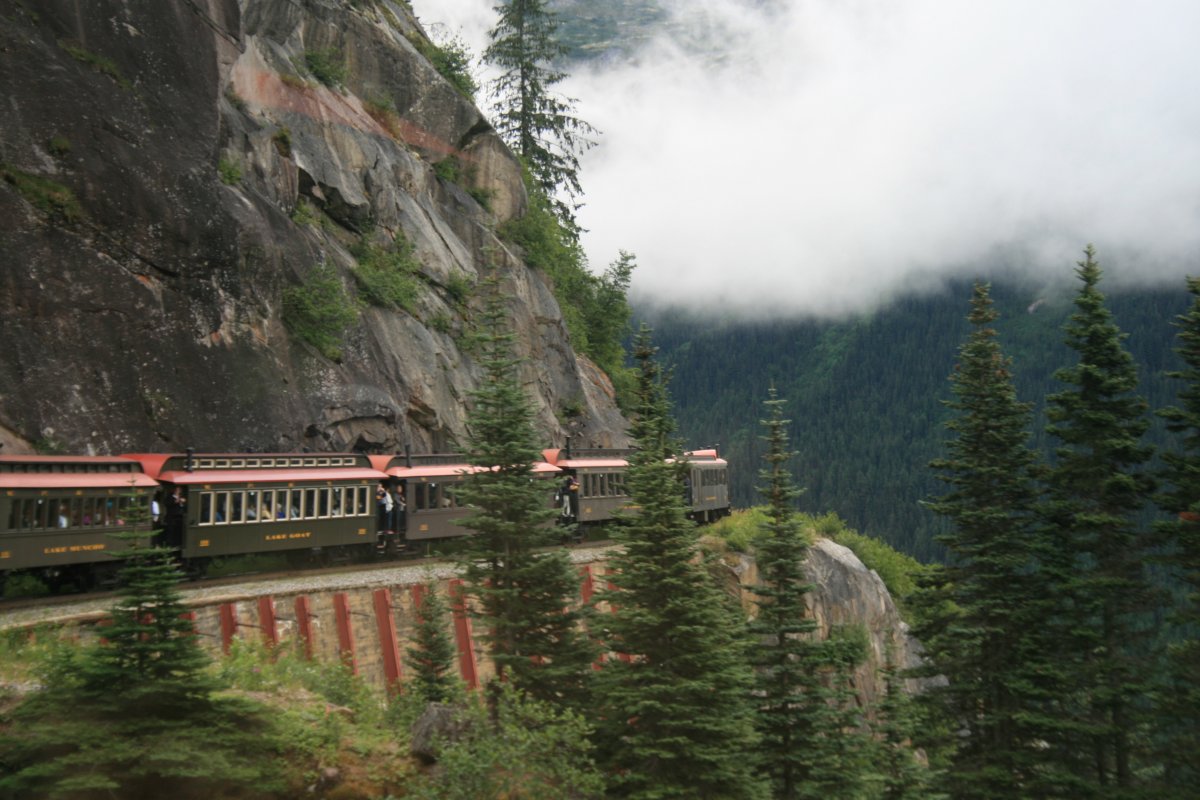 |
|
|
|
| |
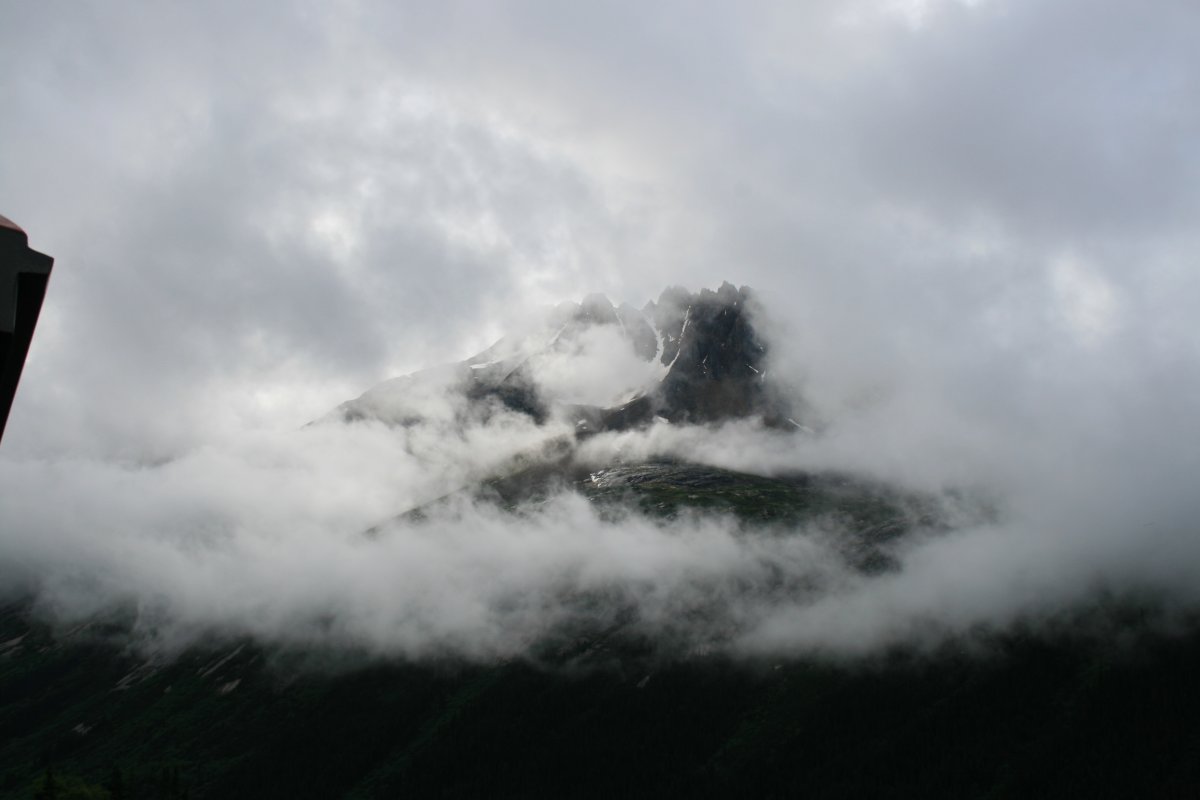 |
|
| There's our boat! |
| |
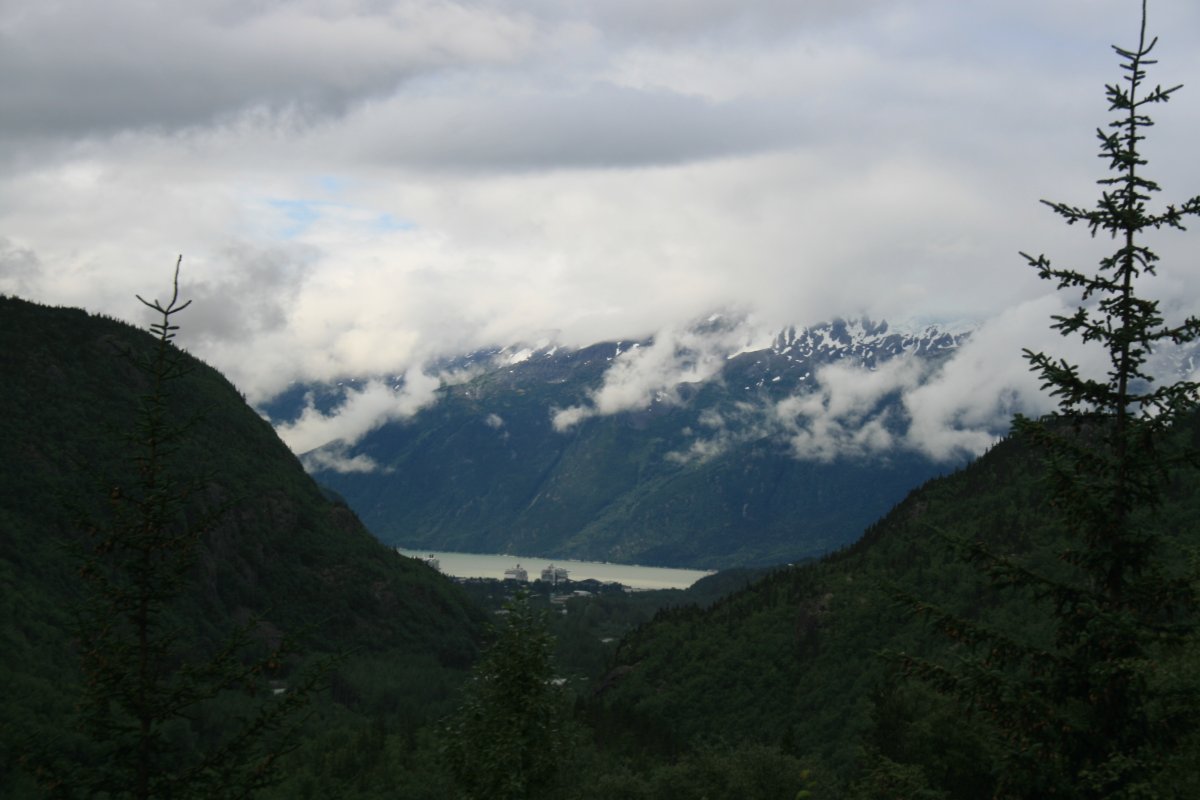 |
|
| Back at Skagway, the railroad shop where the locomoties and cars are maintained. Check out that old steam locomotive. |
| |
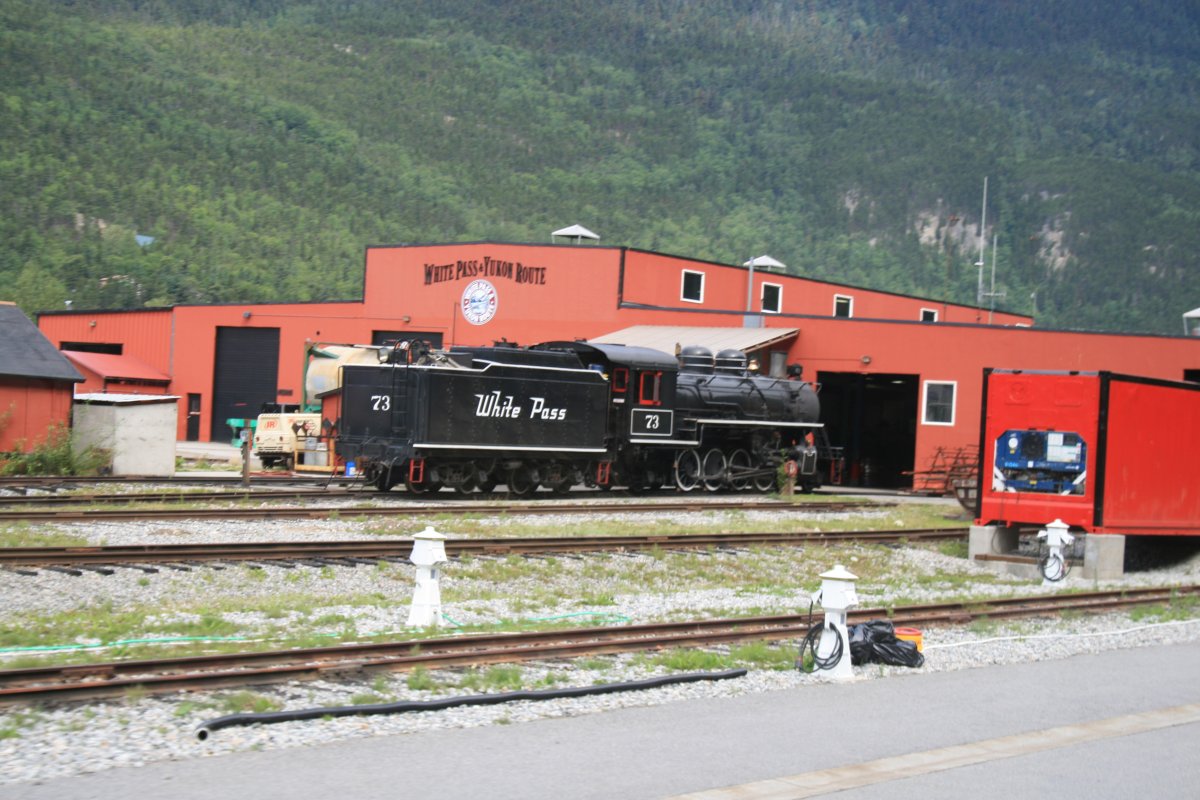 |
|
| After the train ride, we had some time in Skagway. |
| |
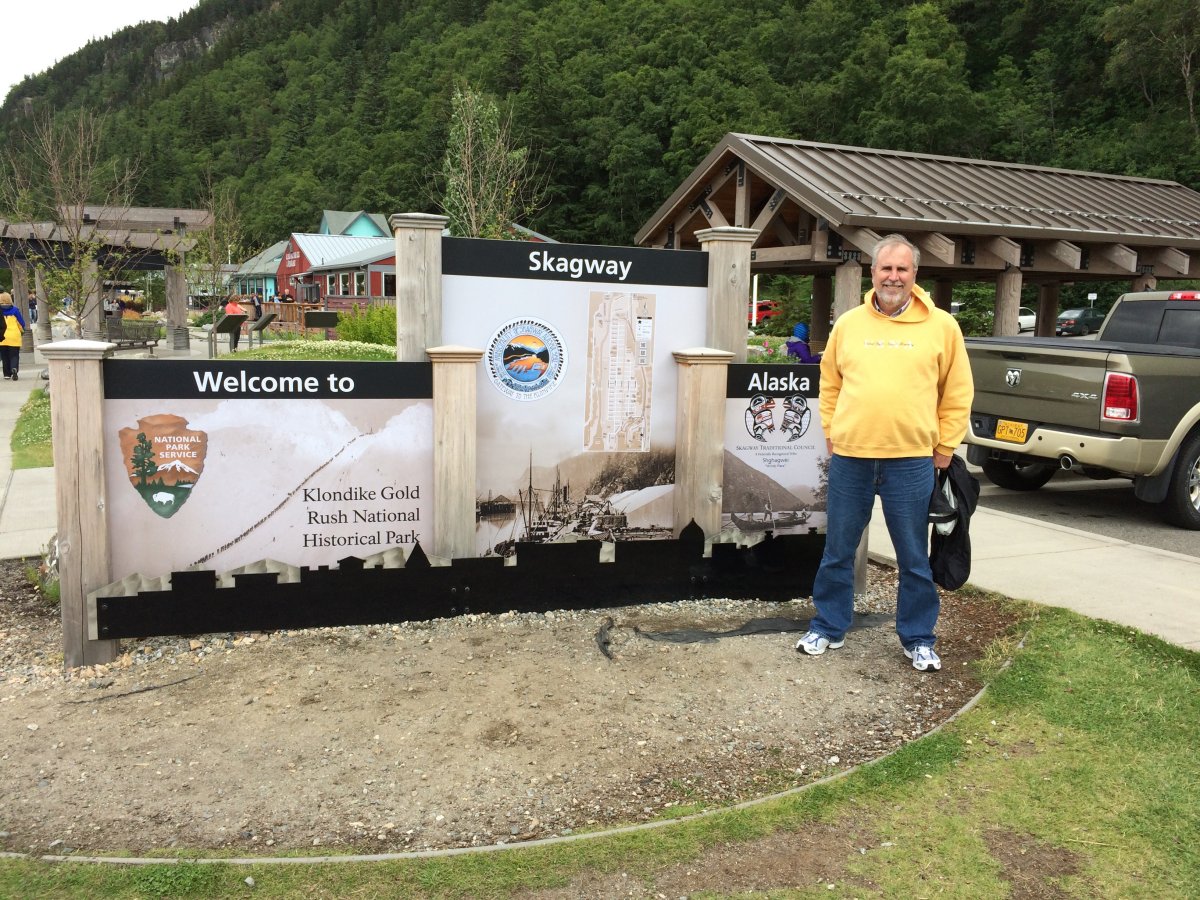 |
|
|
On Broadway Street in Skagway.
|
| |
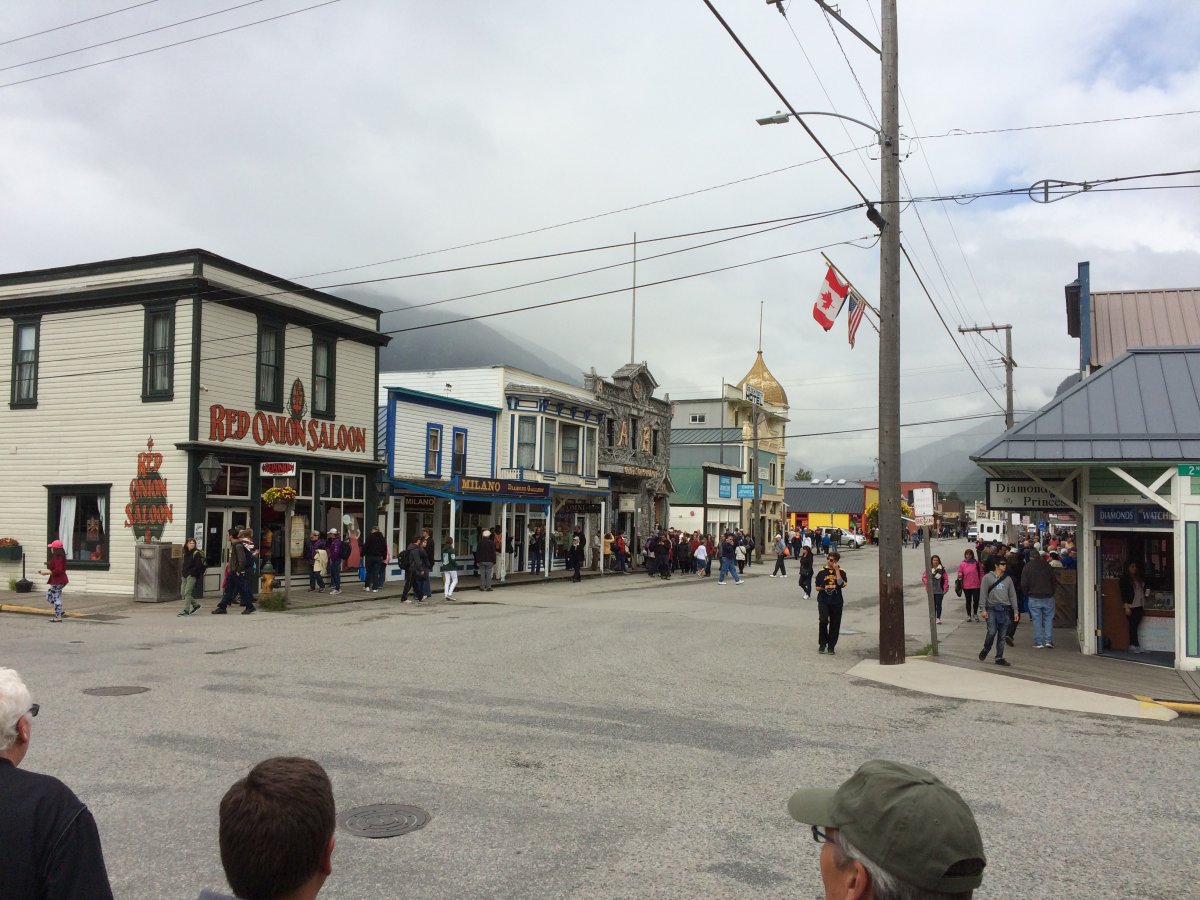 |
|
| A lady of the night harkens back to Skagway's Hell on Earth days. |
| |
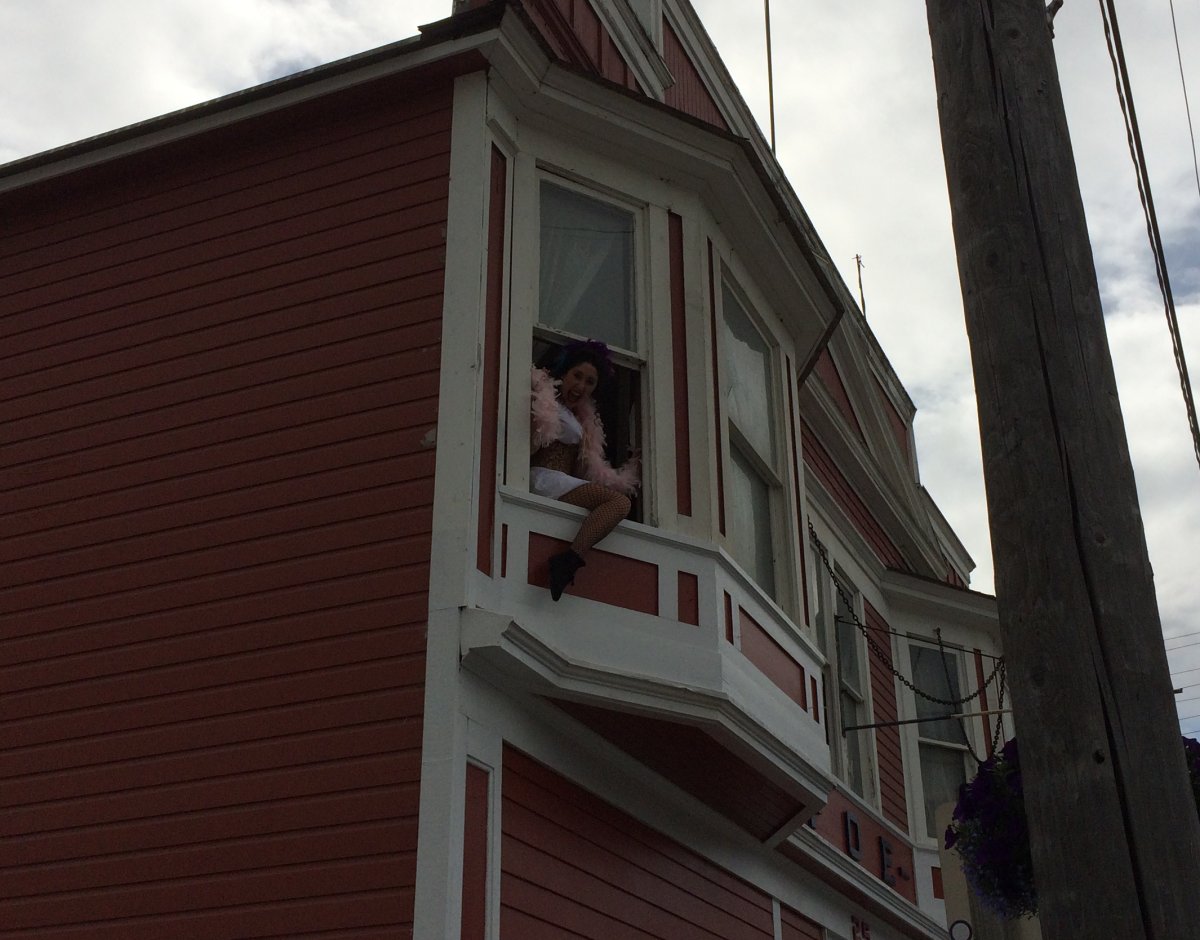 |
|
|
Looking down Broadway towards our ship.
|
| |
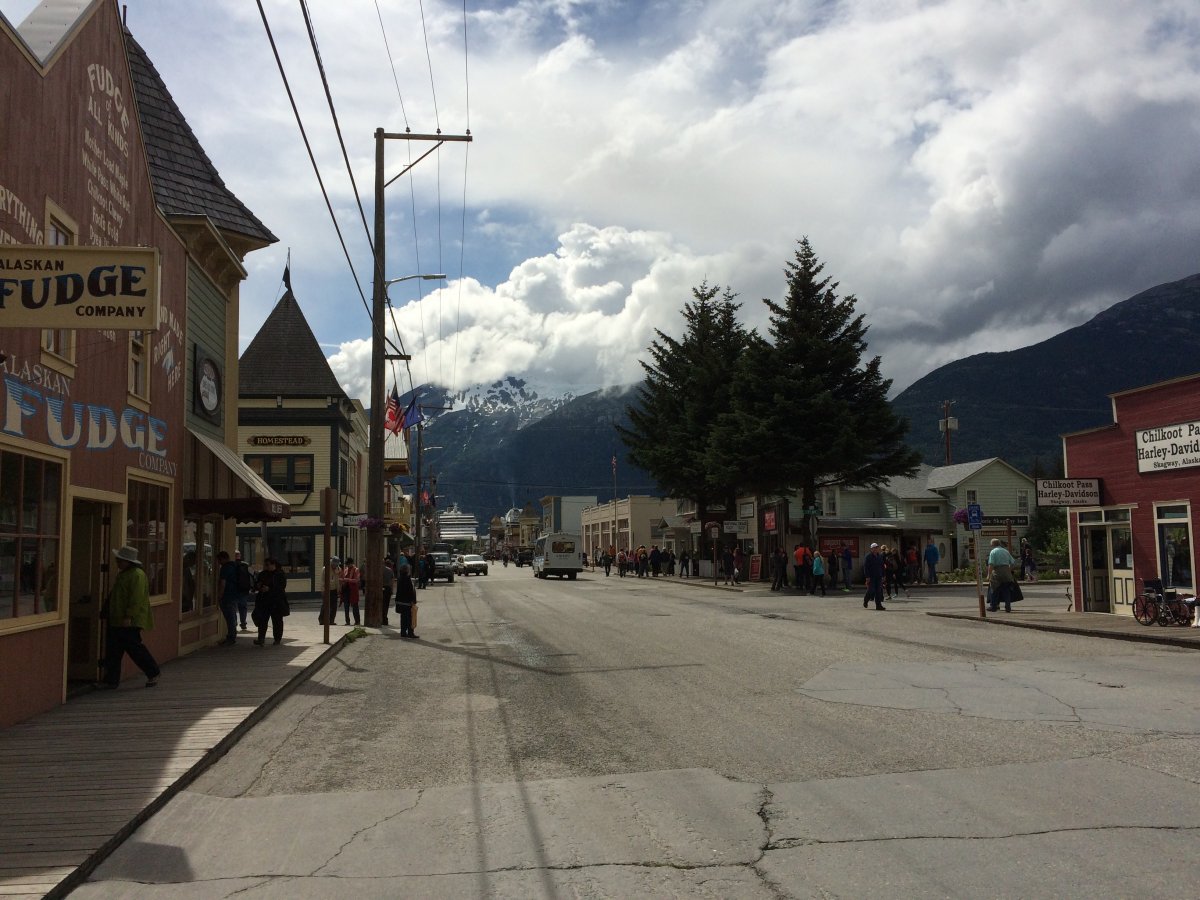 |
|
| Stan hanging outside a bar where we had a few cool ones. |
| |
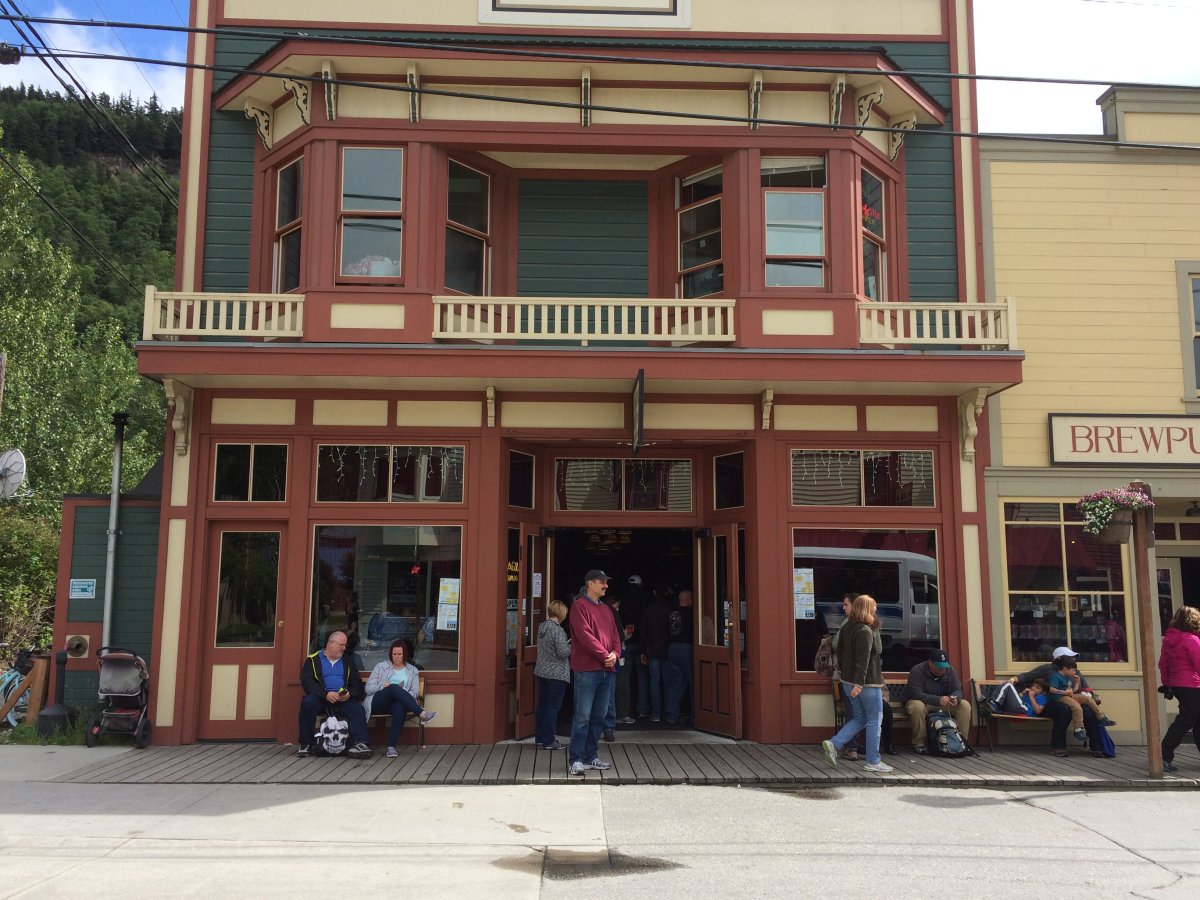 |
|
| We also stopped in at the Red Onion Saloon. |
| |
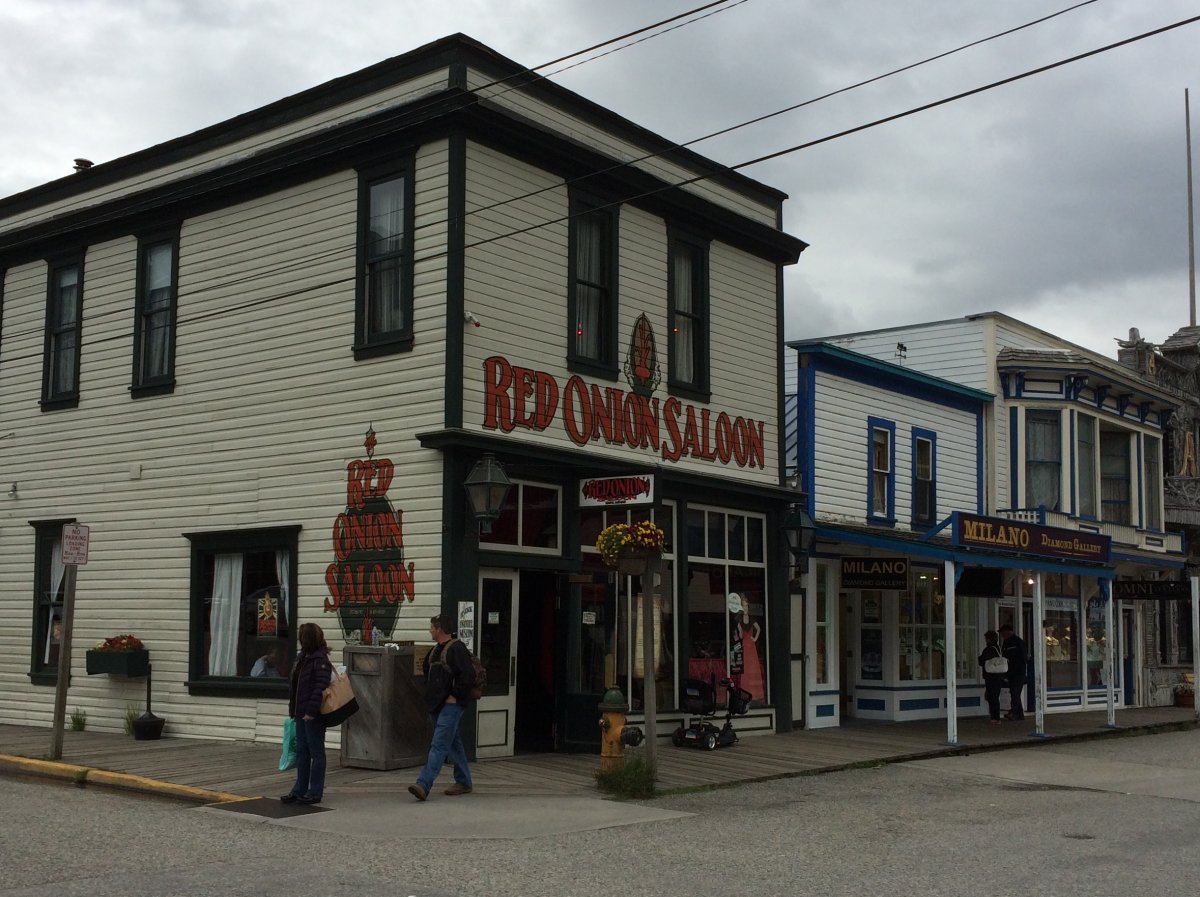 |
|
| Look, Scotty made a new friend! |
| |
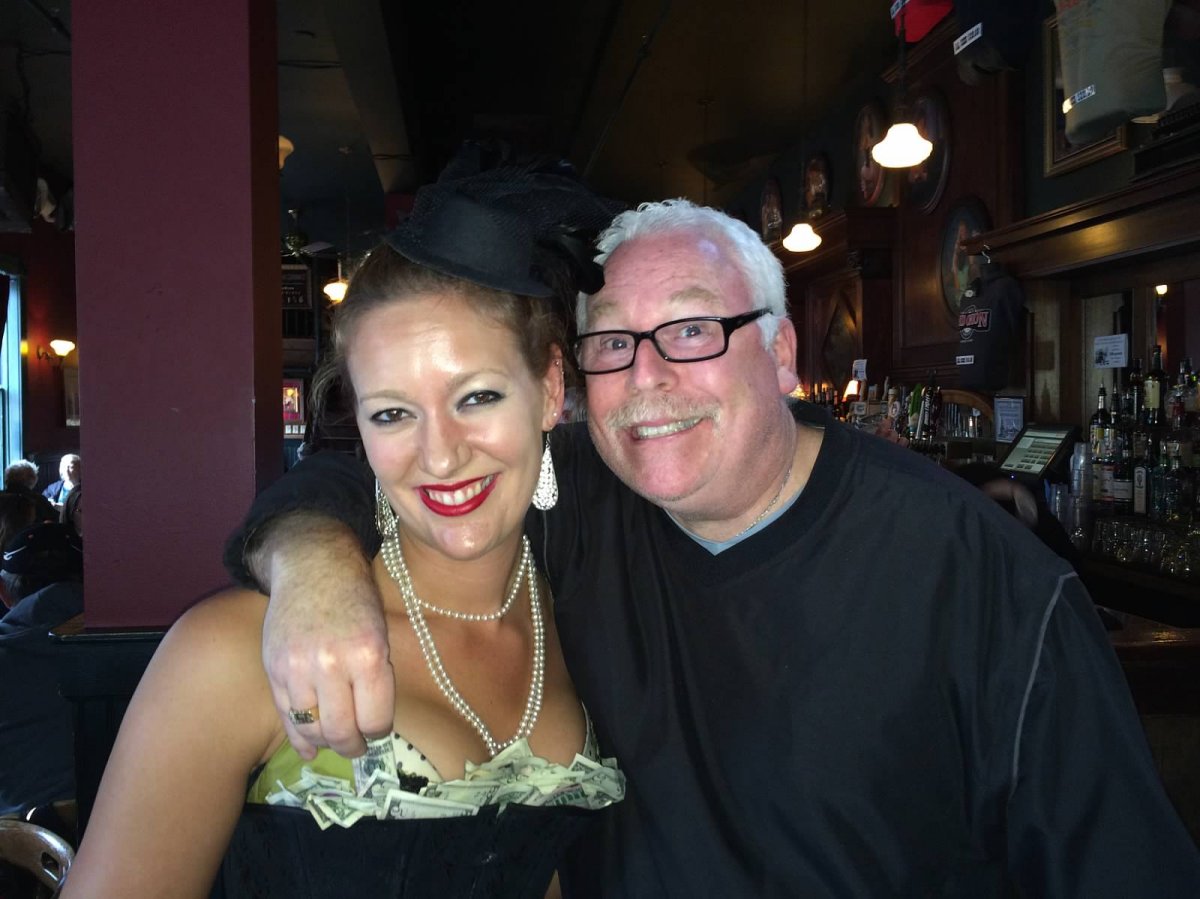 |
|
|
The boys outside the Red Onion Saloon.
|
| |
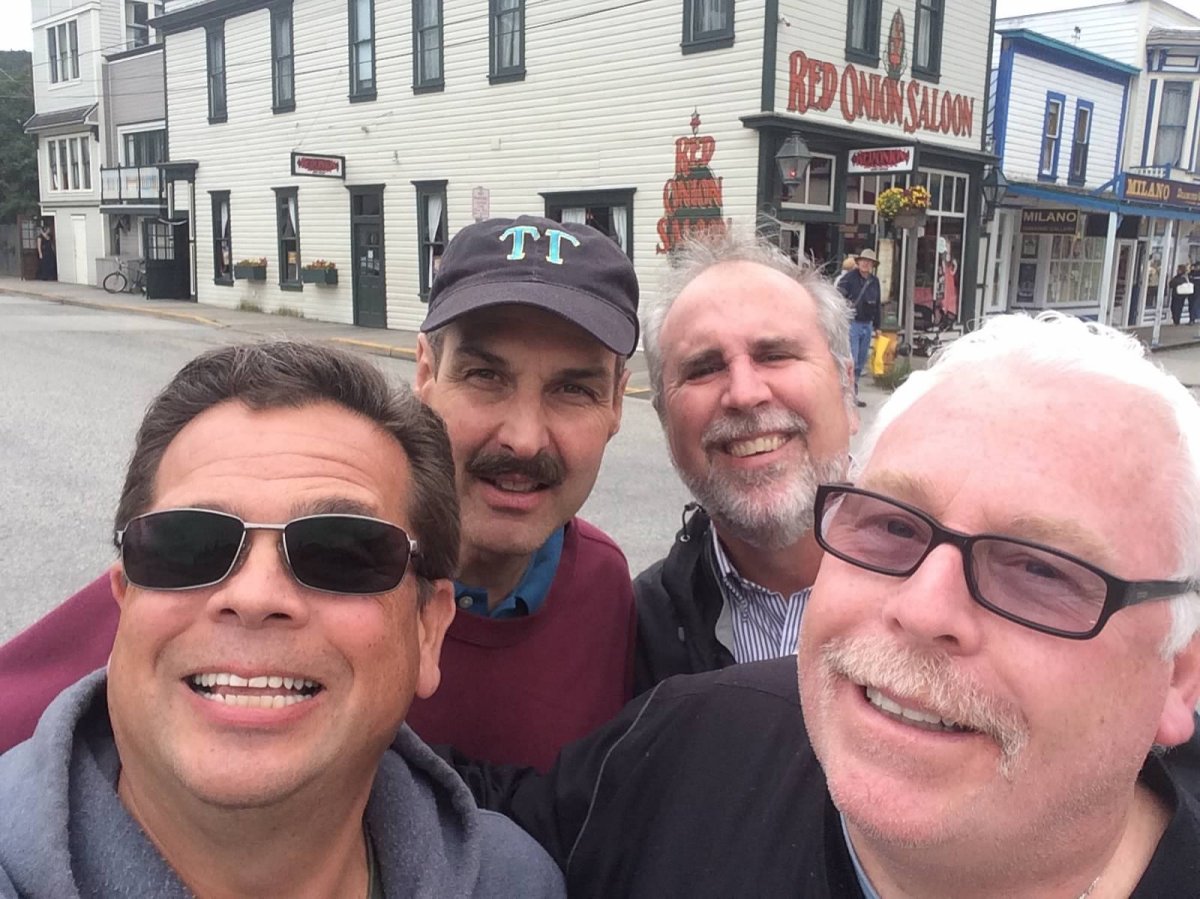 |
|
| The Skagway Centennial Statue |
| |
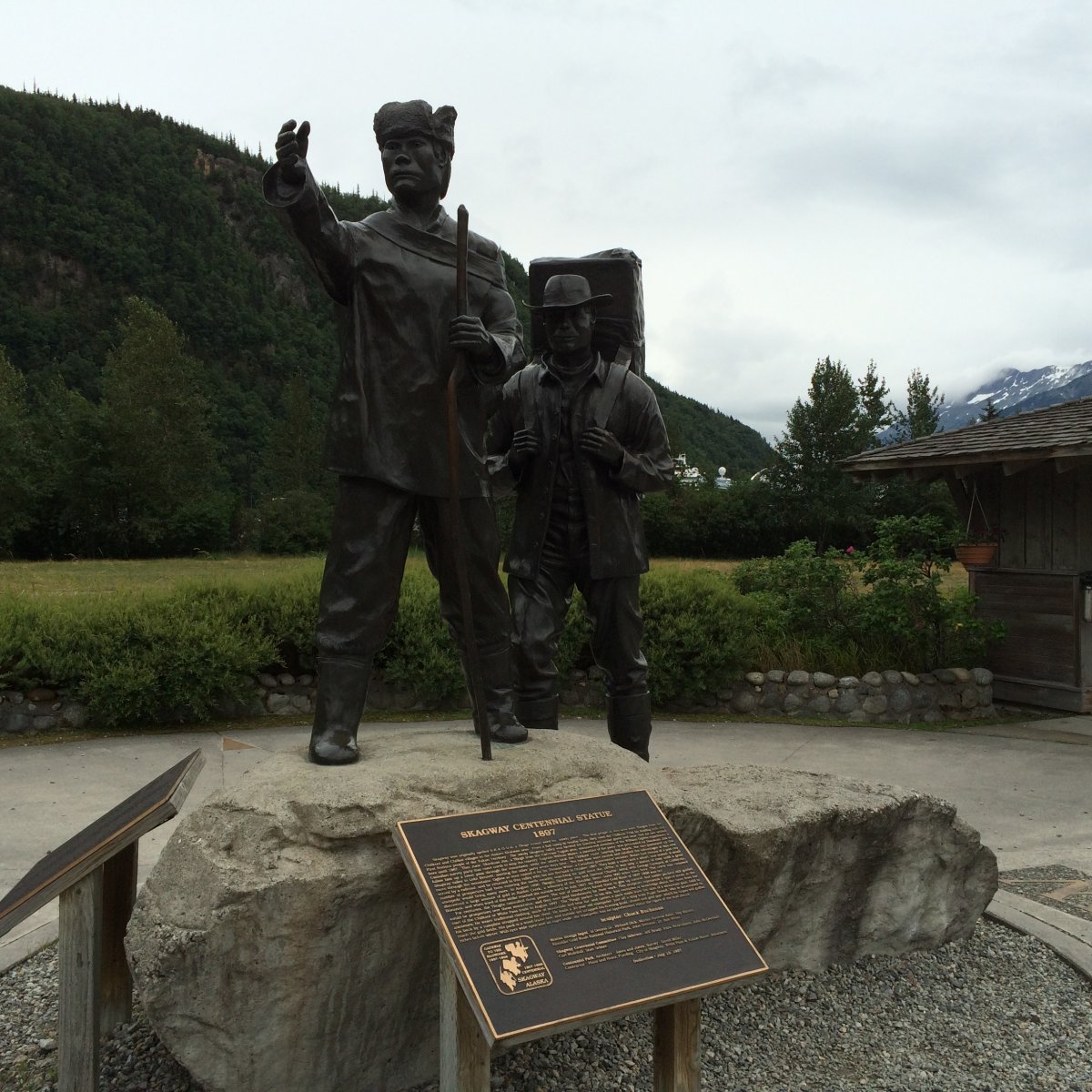 |
|
|
The girls had fun at the garden show and glassblowing demo.
|
| |
 |
|
| The boys had fun drinking beer at the Red Onion. |
| |
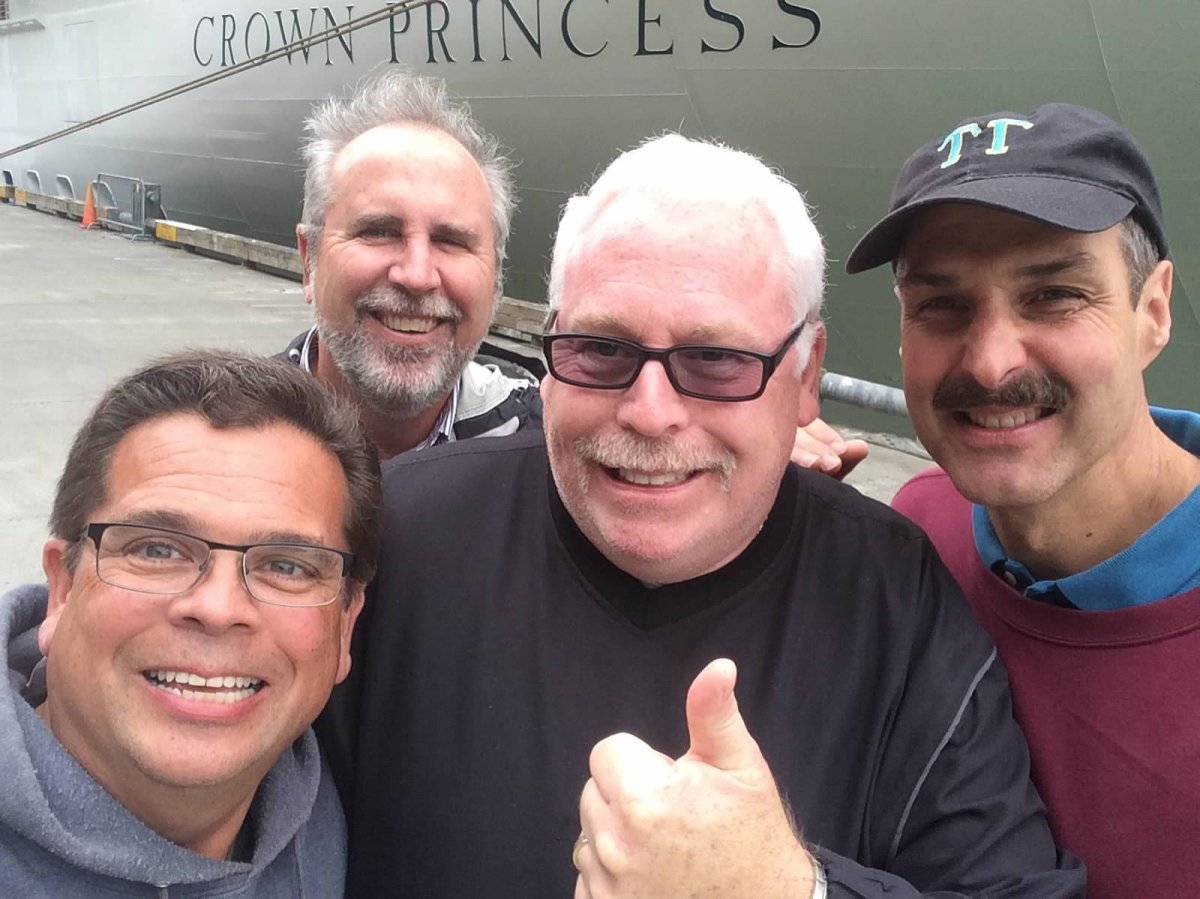 |
|
| Glass blown flowers. |
| |
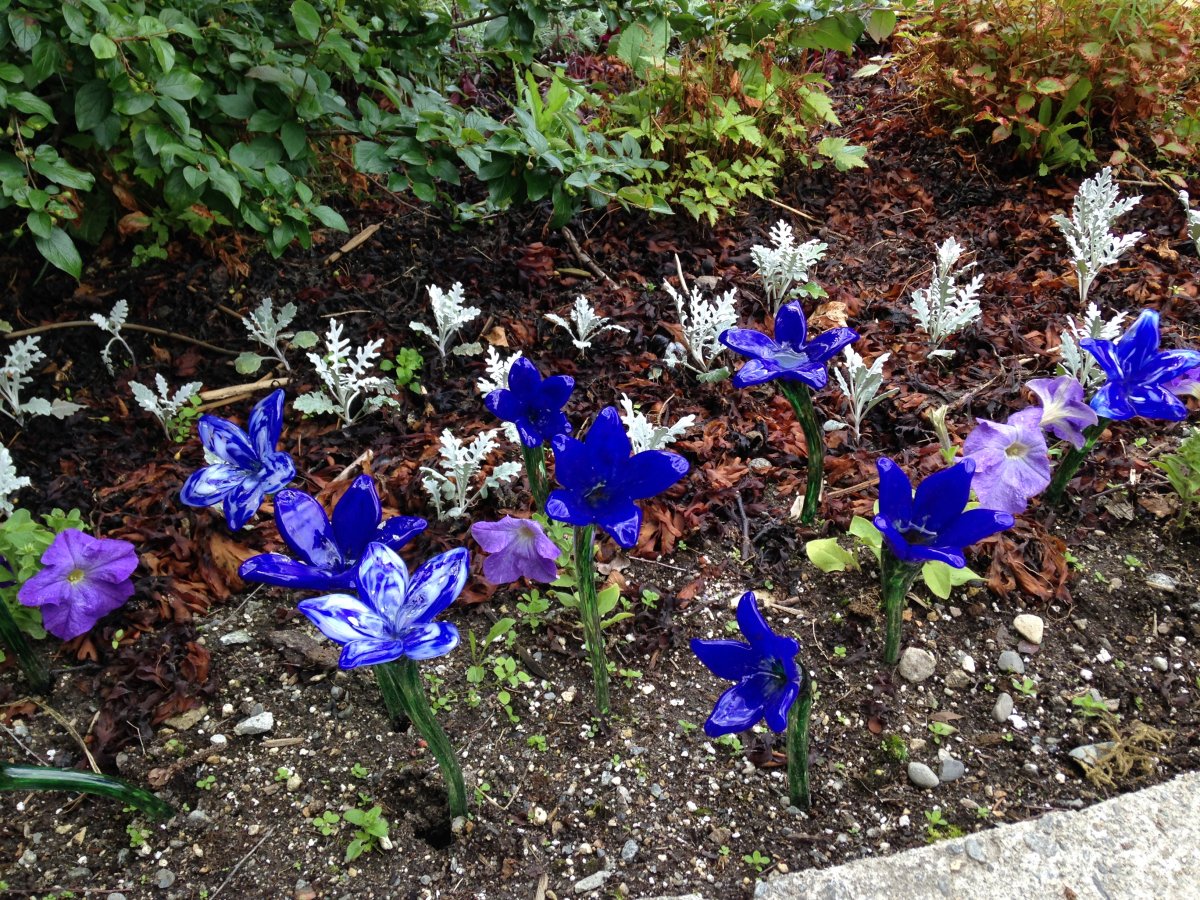 |
|
| Lynnette at the garden show. |
| |
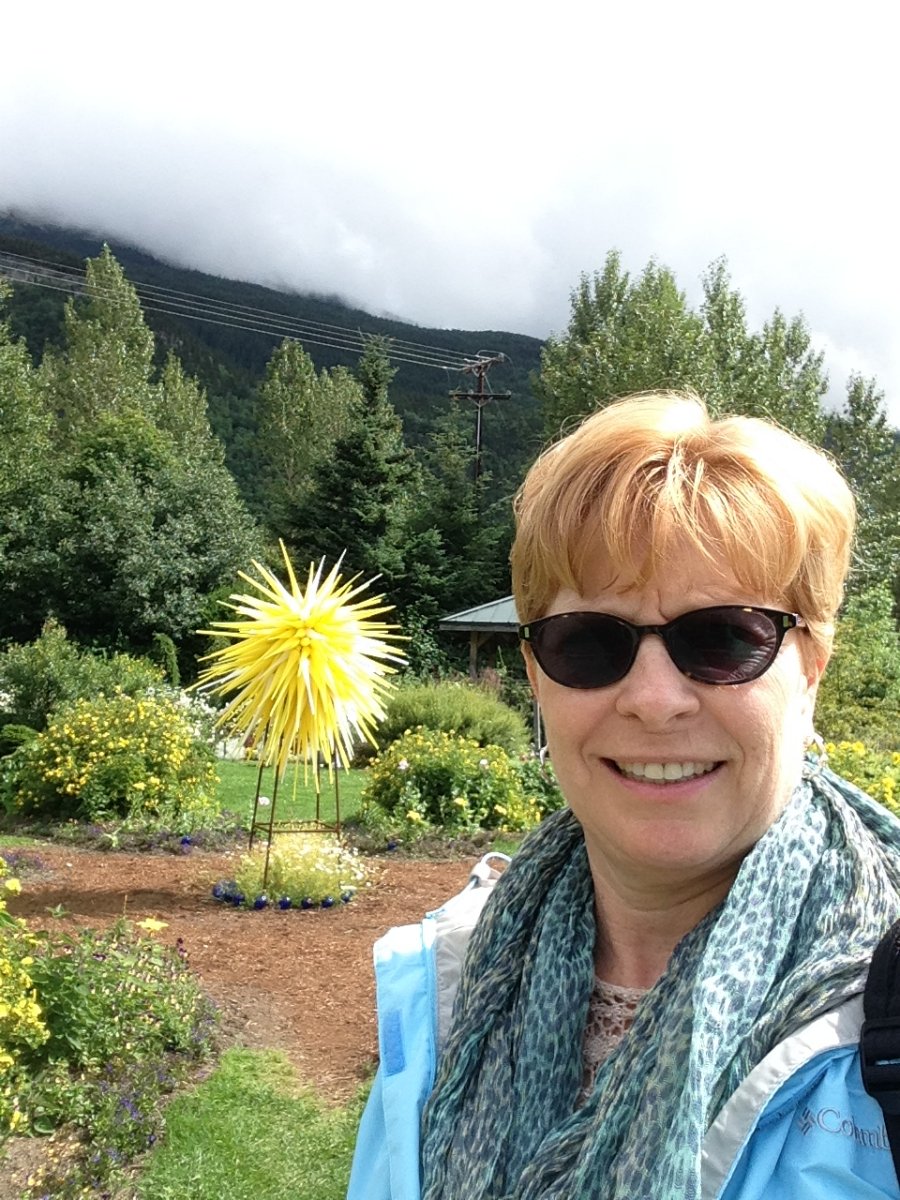 |
|
|
There's our boat.
|
| |
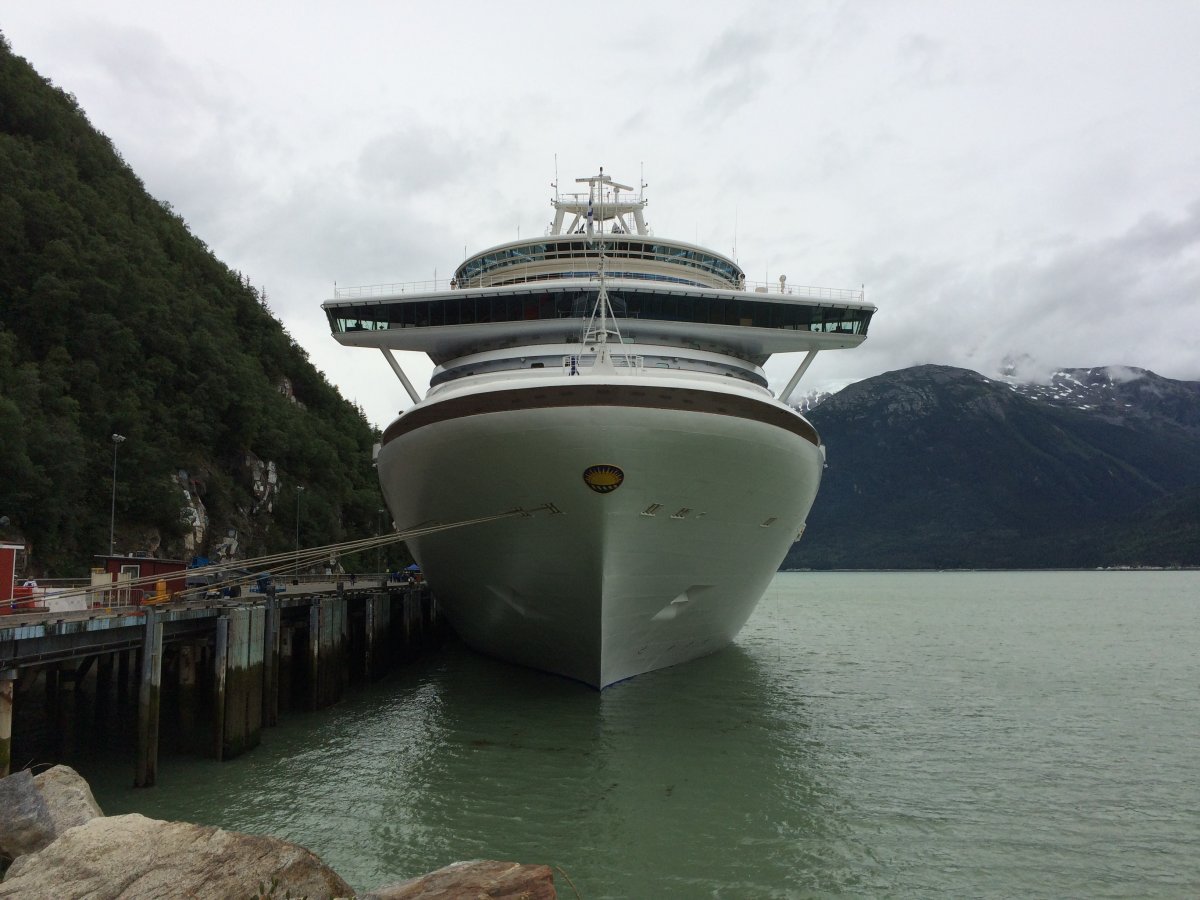 |
|
| |
| |
|
|
|
|
|
|



















































